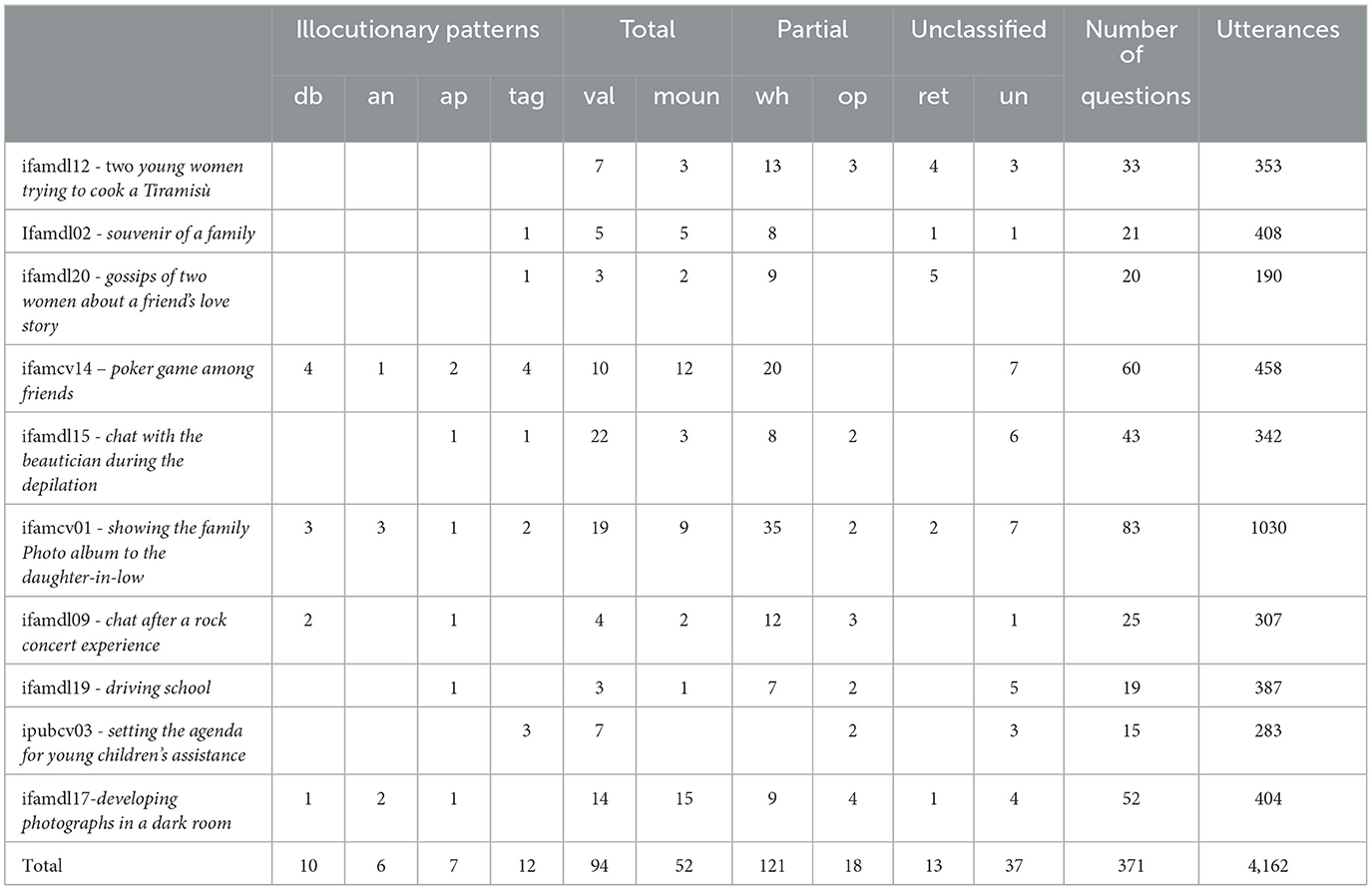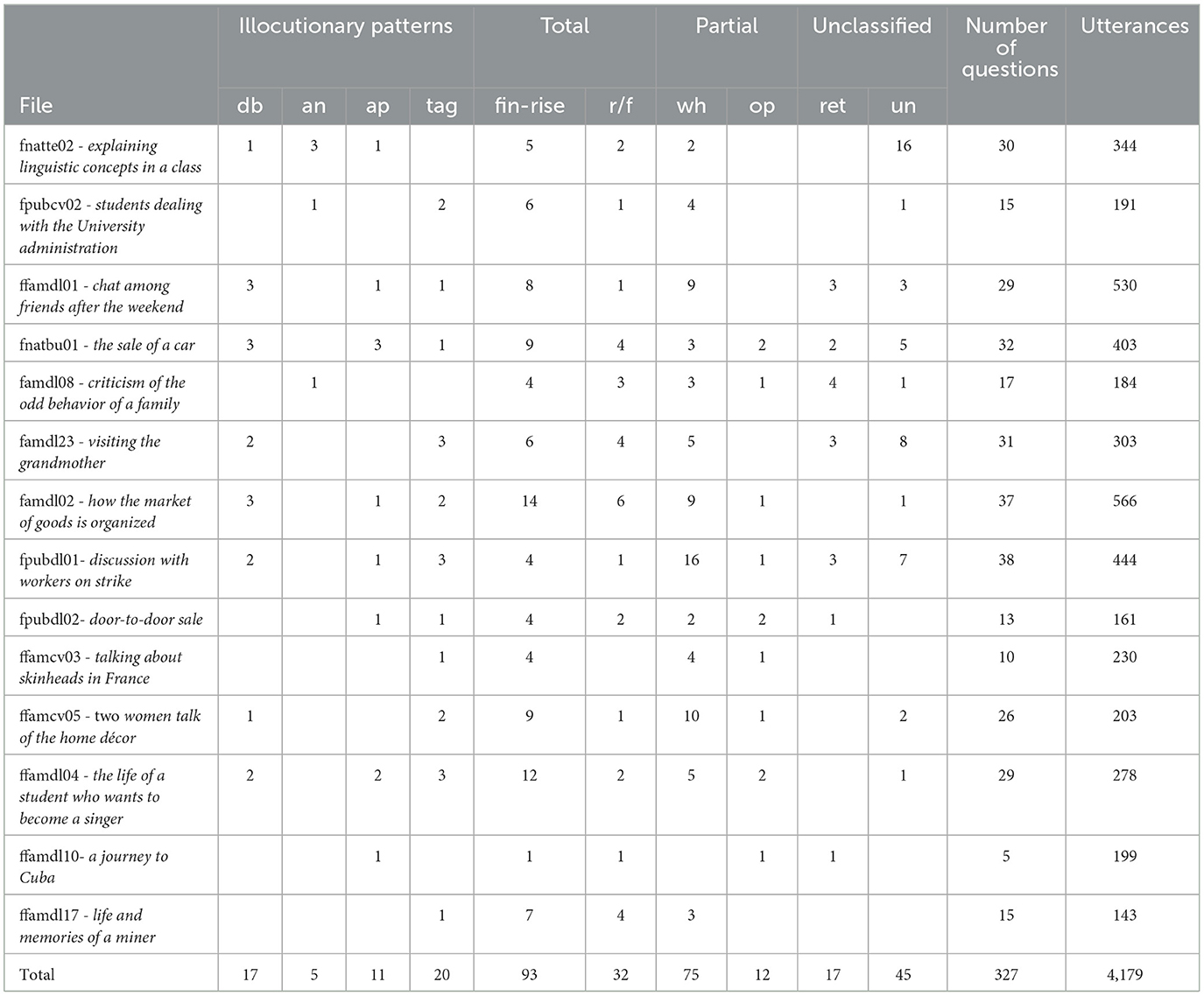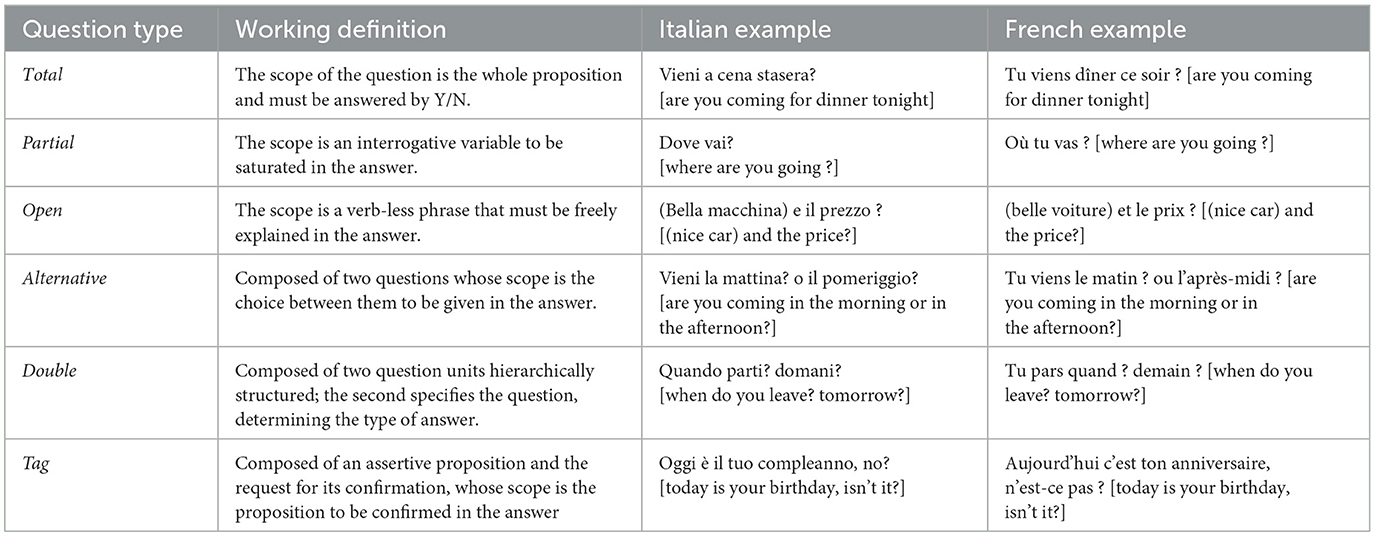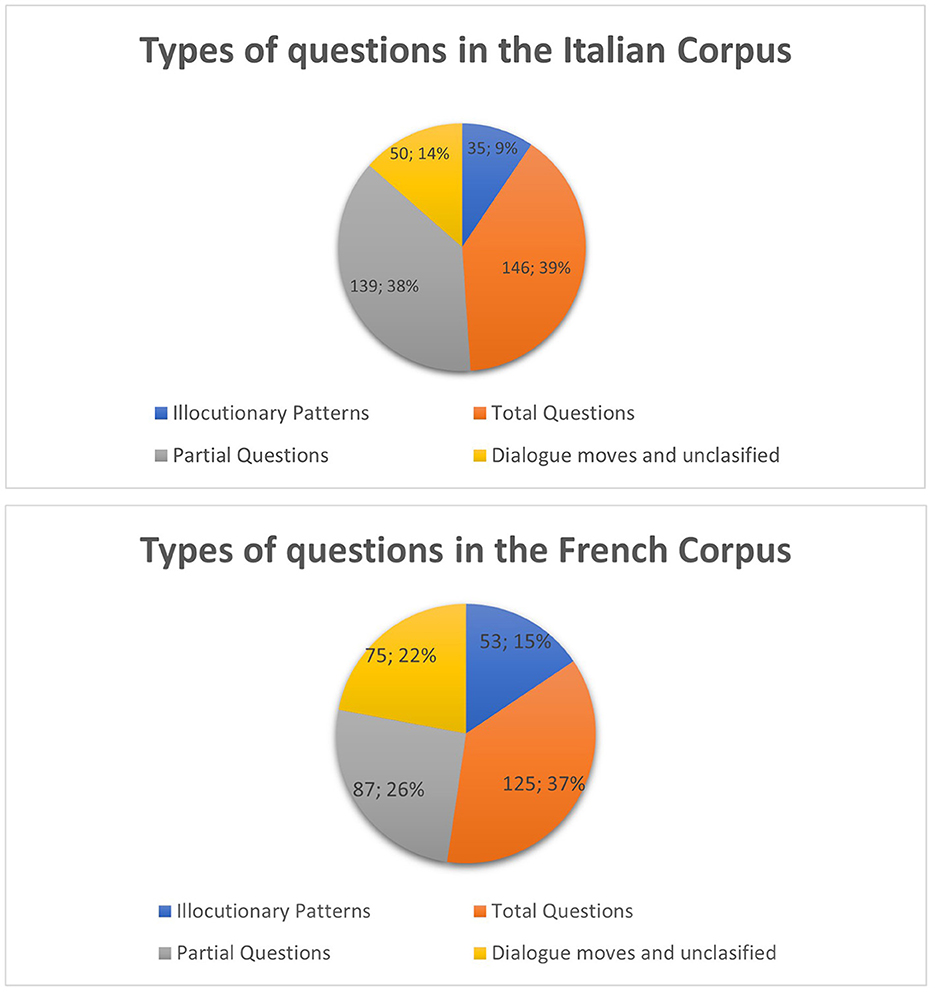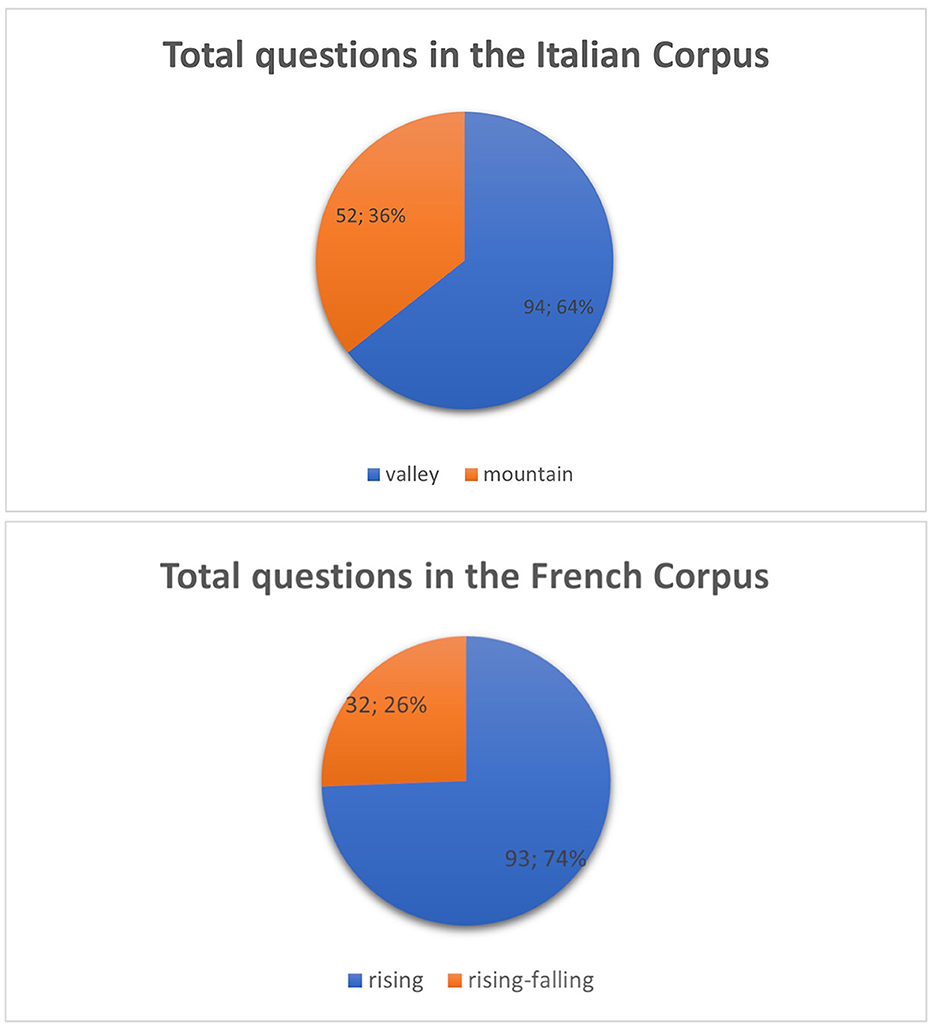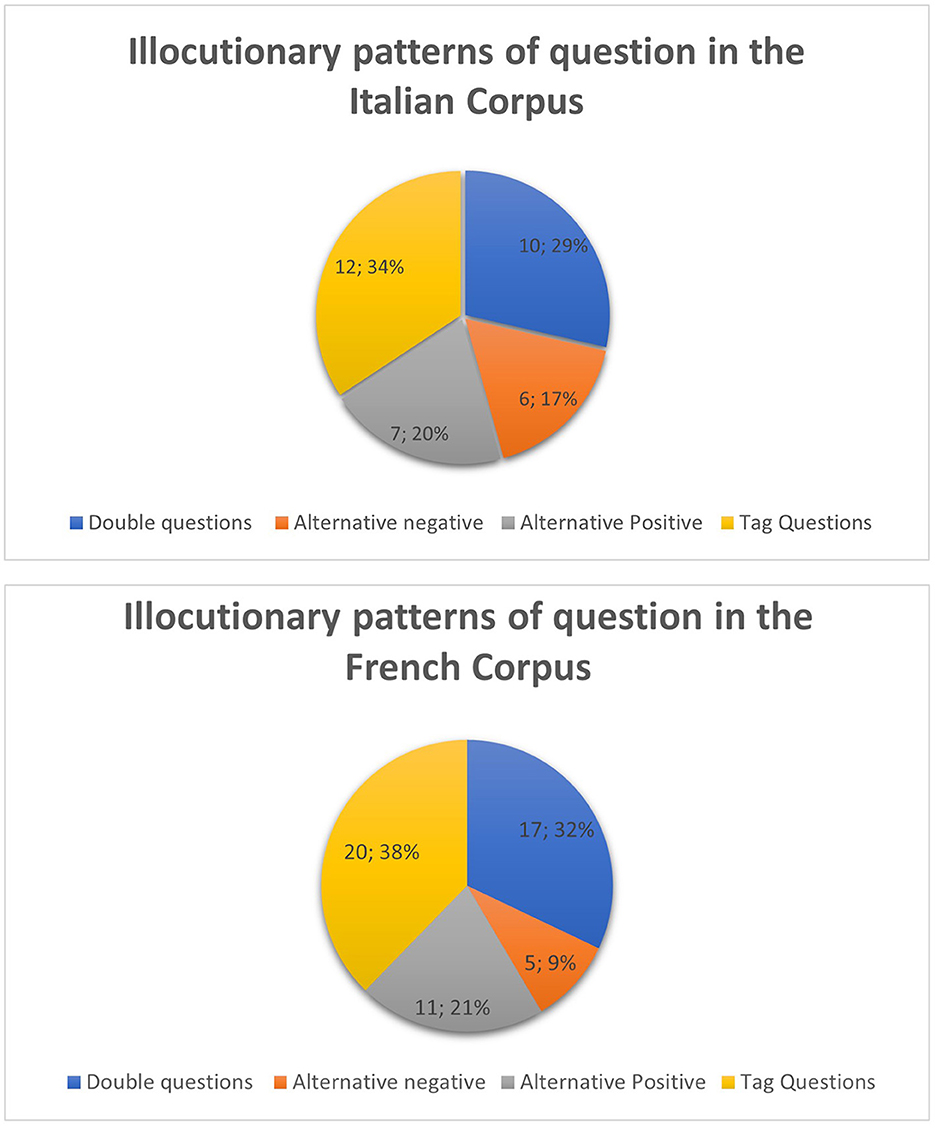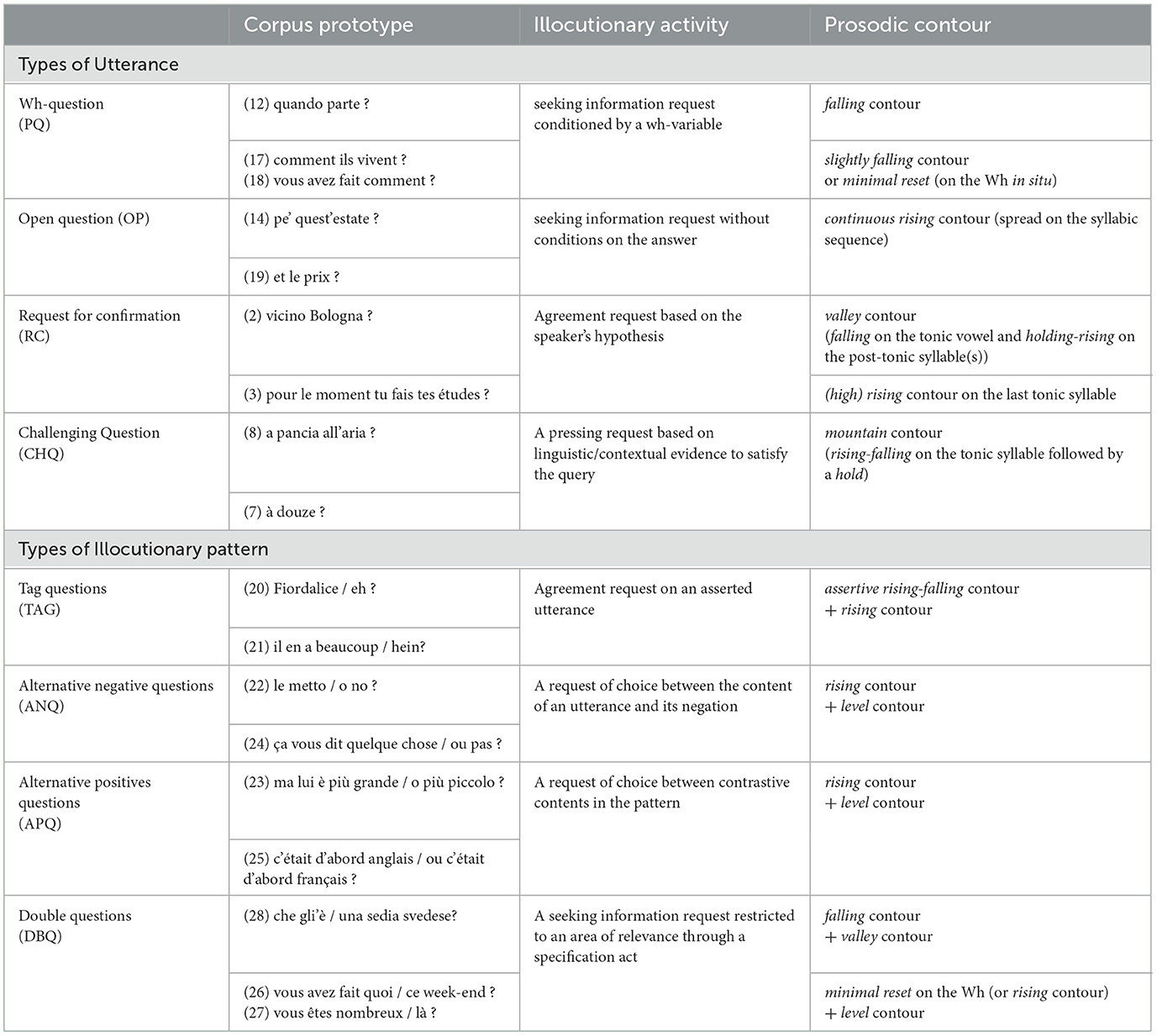- Laboratory LABLITA, Department Lettere e Filosofia, University of Florence, Florence, Italy
This article presents a corpus-based study of the correlations between prosodic contours and question speech acts in Italian and French from the perspective of the Language into Act Theory (L-AcT). A rich taxonomy of question illocutionary types is derived from two comparable corpora of informal speech taken from the C-ORAL-ROM collection and illustrated through prototypic examples. The number of questions in speech is evaluated as <10% of utterances. Despite their syntactic and accentual differences, the two languages share comparable pragmatic values conveyed by defined prosodic variations. Total questions, which can be answered with yes or no, are expected with canonical rising contours. Still, a good percentage shows the so-called declarative prosody (26% in FR and 36% in IT). They have been supposed to be biased by presupposing the proposition's truth and considered Requests for confirmations instead of genuinely Seeking for information acts. But presupposition, depending on intentional states, is hard to be detected, and no clear linguistic correlation was found. The corpus-based study of the prosody/pragmatics relation allows a better understanding of the system. Total questions should be framed within the larger category of Directives aimed at the addressee's linguistic behavior, which does not foresee seeking information as the only goal. When the speaker makes a hypothesis on what he asks—that is not an actual presupposition—he performs a Request for confirmation. This is true in most Total questions, and prosody complies with the canonical contour. In contrast, declarative contours correlate with corpus contexts in which the speaker does not make any hypothesis but puts pressure on the addressee (Challenging Questions). Partial questions genuinely seek information and comprise Open questions, which are verbless utterances where the addressee is requested to freely provide information on a given topic. Tag questions, Double questions, and Alternative questions correspond to Illocutionary patterns that, according to L-AcT, are composed of two pragmatic units framed within one prosodic strategy.
1. Introduction
The investigation of how prosodic information varies across the most diverse situations of real life requires access to spontaneous speech corpora and linguistic methodologies, which can bootstrap the relevant prosodic information conveying meanings from a continuous stretch of speech.
This article presents the main results achieved during a corpus-based analysis of a representative selection of the C-ORAL-ROM Corpus of Spoken Italian and French (Cresti and Moneglia, 2005) dedicated to the induction from corpora of the pragmatic and prosodic properties of questions in these two languages. Corpora mainly represents the Florentine variety and the south France variety.
The Language into Act Theory (L-AcT), which is the framework adopted for this study, foresees that prosody is the interface between the affective/pragmatic programming of the utterance (illocutionary act, Austin, 1962) and its linguistic fulfilling (locutionary act), and it is necessary to speech acts performance and interpretation (Cresti, 2000, 2020; Moneglia, 2011).
This article focuses explicitly on the prosodic variations that characterize Yes/No questions in Italian and French, constituting a problematic case study for the pragmatics/prosody correlation. There are many Y/N questions departing from the canonical prosodic model foreseen in the two languages. They convey a so-called nuance of meaning which has been questioned in previous literature.
Indeed, speech acts taxonomies based on spoken corpora have been recently developed, enriching the tradition that origins in Austin (Austin, 1962; Searle, 1979; Searle and Vanderveken, 1985). These taxonomies provide concepts that ground new-generation pragmatic classifications in language usage.
The DART-DAMSL repertory (Weisser, 2018) sets questions under the label of seeking information acts and divides the category into the following types: Yes/No, Declarative Y/N, Back-channel, Reformulating, Open, Rhetorical, Alternative, and finally, Tag Questions, which are Requests for Confirmation (RC).1 Illocutionary types are identified through prototypical sentences that substantiate each definition.
According to the DITT++2 tag-set (Bunt et al., 2017), questions share the goal that the speaker wants to know something, which he assumes the addressee to know, and puts pressure on the latter to provide this information. The class records the following: Set Question (WH), Proposition Question (Y/N), Check Question (RC), and Choice Question (Alternative questions). An explicit distinction between Proposition questions (Y/N) and Check questions (RC) is proposed: in Y/N, the speaker wants to obtain information about the truth of a proposition, while in RC, the speaker seeks to get information about the truth of a proposition he weakly believes is true. This distinction is problematic for speech act interpretation since it is not explicitly reflected in any linguistic condition. Still, it is based on the speaker's state of mind, which is unavailable. Therefore, any Y/N question (has the train left?) is a possible candidate for both interpretations. Neither DART nor DIT++ considers prosodic cues.
In conclusion, corpus-based pragmatic taxonomies foresee a pragmatic distinction within Y/N questions among those which are genuinely seeking information acts, considered unbiased, and those characterized by the speaker's presupposition of the truth of the proposition, considered biased, i.e., Requests for confirmation. However, this distinction is neither correlated with prosodic performance nor can be predicted because of objective linguistic features.
However, a variation in the prosodic form of Y/N questions has been found in corpora; in short, both rising and rising-falling contours are widely reported in Italian and French studies. For Italian, a substantial body of research deals with the prosodic performance of Y/N questions in most Italian regional varieties (D'Imperio, 2001; Grice et al., 2005; Gili-Fivela, 2008). Within the Auto-segmental Model (Pierrehumbert and Hirschberg, 1990; Ladd, 2008), a falling-rising prosodic performance (L*+H, LH%) is assumed to express an overall meaning relative to the interrogative modality as opposed to the declarative one, which in Italian are not distinguished from a syntactic point of view.
Research on task-oriented speech corpora was run on the CLIPS corpus, which collects Map Task dialogues (Anderson et al., 1991) across the main Italian regional varieties. In Crocco (2006), the prosodic features and a fine-grained pragmatic analysis of Y/N questions have been annotated according to the HCRC Map task coding scheme, where Y/N questions are considered Dialogue moves which vary according to their informational value. However, the expression of the different nuances of meaning conveyed by prosodic contours appears fragmented, depending on various aspects (linguistic filling, interaction, and context).
In Savino (2012), only unbiased Y/N questions have been prosodically analyzed in all Italian varieties of CLIPS. For what concerns the Florentine variety, two contours have been observed, both characterized by a rise on the tonic syllable, respectively, followed by a low boundary tone (L+H* L-L%) and a rise boundary tone (L+H* L-H%). Crucially, no strict pragmatic correlation of this variation has been observed.
Rossano (2010) grounded his corpus-based research on spontaneous conversations by people from the Northern variety and observed a prosodic variation in Y/N questions. He found that Y/N questions (60% of all questions in his corpus) are used to implement various actions. Half of them are requests for confirmation, while only 26% seek information. However, also in this work, no specific correlation between the so-called social activities and prosodic variations is stated.
For what concerns the French, the volume by Grundstrom and Léon (1973) remains one of the most accurate descriptions of the prosodic varieties carried out through f0 measurements and experiments. Grundstrom provides the prosodic analysis of a significant group of utterances derived from a spontaneous conversation, developing every type of illocution. Three contours have been associated with interrogative values (raising, flat rising, and rising-falling). Validations through perception tests confirmed that the rising and flat-rising contours are the most relevant for the recognition of questions, primarily if they are associated with a short climb duration and high intensity of the last syllable, while the rising-falling contour is mainly paired with assertive utterances.
Fonagy and Brerard (1973), in their work on Y/N questions, found an overall rising contour with a moderate climb signaling the performance of neutral instances. The contour is described as a slower climb at the beginning, which then accelerates and remains high, forming a convex curve on the final syllable. However, they also noticed other types, the so-called implicative questions, which from a semantic perspective should imply a speaker's doubt. They still bear a rising contour that, after a sudden rise on the penultimate syllable, shows a significant fall on the last syllable. In comparison with assertive contours, they are called declarative questions. However, the peak of declarative questions is higher, and the interval between peak and fall is sudden in the latter and broader in the assertive contours. Declarative questions fall abruptly and deeply, while in assertive, the fall rarely reaches the base landing level.
The prosodic characters of the interrogation have been recently taken up inside general treatises on French prosody (Hirst and Cristo, 1998; Lacheret-Dujour and Beaugendre, 1998; Rossi, 1999; Martin, 2009). All authors agree on an overall description of a rising contour on the last syllable, Contour melodique Ci (H*H%), in Martin (2015) terminology. The variability of performance depending on regional varieties and attitudinal aspects is often highlighted.
Delais-Roussarie et al. (2015), in their masterwork, develop a semantic classification of the different types of prosodic performance of questions. They are exemplified through best examples produced in the laboratory or derived from corpora collecting different regional varieties. The typology regarding Y/N questions can be summarized in two major types: information seeking that is realized by a rising contour (H*H%), mostly very high, and imperative Y/N that is performed by a rising-falling contour (LH*L%).
Portes (2020) investigates the meaning of intonation questions with rising-falling contour. She wonders whether to link this specific contour to a biased trait, noticing that, for instance, in Catalan, the positively biased questions bear a rising-falling contour (Vanrell et al., 2013). Moreover, the author disputes the relevance of an independent contour with an f0 peak on the penultimate syllable, which would be due to uncertainty and, therefore, negatively biased. An experiment has been conceived where the same sentence was proposed with four prosodic contours. Participants have been requested to correlate the different performances to a previously determined set of semantic/pragmatic values. The falling contour was coupled with assertion and the rising contour with question, and the form of uncertainty has mainly been assimilated to the rising contour and interpreted as a generic question. The most controversial results are those regarding the rising-falling contour, which is supposed to be less grammaticalized, more expressive, and sensitive to context (Portes and Lancia, 2017; Portes, 2020).
Beyond Italian and French, relevant work on the prosodic analysis of questions in American English-spoken corpora was run by Hedberg et al. (2017). It explicitly correlates pragmatic values and prosodic performance. In American English, questions have canonical prosody: Y/Ns are rising, while WHs are falling. However, non-canonical prosodic contours have also been found, although in a small minority. They are used to signal when the speaker does not genuinely seek information, since they fail to fit with one or more standard felicity conditions of questions, i.e., the speaker's ignorance of the answer, his desire for an answer, and his belief in the addressee's knowledge. In short, they are biased. The small percentage corresponding to non-genuine Y/N questions shows a Level prosodic contour that can be either (L*H-L%) or (L*L-L%).
Based on corpus evidence, we will argue that Y/N questions—Total questions in our terminology—are not only seeking information acts centered on the speaker but must be framed within the overall Direction class and the larger pragmatic concept of request for linguistic behavior to the addressee. Specifically, two pragmatic types result in Request for confirmation (RC) and Challenging questions (CHQ). RCs are the most frequent type in the two languages and are performed by dedicated contours, named valley for Italian and final rising for French, while the rising-falling contour signals CHQs in the two languages.
Beyond Total and Partial questions, rich taxonomy of illocutionary types is derived from our corpus-based study when considering the pragmatics/prosody correlations. Types that have received less attention in previous literature have been recovered systematically in our corpora and will be framed in a comprehensive classification that turns out valid in both languages. Open questions are verbless utterances where the addressee is requested to provide information on a given topic freely. Tag questions, Double questions, and Alternative questions, considered Illocutionary patterns in L-AcT, are a sequence of two pragmatic units framed within the same prosodic strategy. All question types present differential prosodic contours that will be described here using prototypical utterances taken from corpora.
In section 2 we will briefly present the methodology, first sketching the essential features of the L-AcT framework and its annotation scheme and then the strategy of the corpus-based work. The criteria for selecting questions are stated, and the dataset derived from corpus analysis is displayed in the tables. The quantitative distribution of question types in our Italian and French corpus samplings is derived.
Section 3 is dedicated to results describing the main illocutionary types and corresponding prosodic contours in the two languages. Within Total questions, Requests for confirmation and Challenging questions are distinguished in correlation to their canonical or declarative prosodic contours. In our analysis, Partial questions, the only genuine seeking for information activities, are then considered and the specific category of Open questions is highlighted. Finally, we will give a unified picture of the prosodic and pragmatic properties of Tag questions, Alternative questions (positive and negative), and Double questions, which are all framed into the Illocutionary pattern strategy foreseen by the L-Act approach.
2. Methodology
2.1. The L-AcT framework
L-AcT is based on the relation between the accomplishment of speech acts and their prosodic performance, which is considered a necessary means for assigning a pragmatic value to speech. L-AcT develops a methodology that is adequate for studying speech in real contexts and has been conceived in Italy, independently, but in parallel, to the Macro-syntactic approach developed in France (Blanche-Benveniste, 1997). L-AcT has been applied to large-scale Romance and English corpora (Cresti and Moneglia, 2005; Mello and Raso, 2012; Cavalcante and Ramos, 2016).
The utterance is assumed as the primary reference unit for speech analysis since it is the minimal entity that can be pragmatically interpreted (Biber et al., 1999; Cresti, 2000; Izre'el et al., 2020) being the linguistic counterpart of a speech act (Austin, 1962). Since corpus data are not only composed of isolated nuclear utterances, as is often the case for the examples reported in competence-based approaches, the study of speech acts also requires the identification of the stretch of speech that accomplishes the illocutionary activity.
Prosody is crucial to speech segmentation (Izre'el et al., 2020). The L-AcT methodology is based on recognizing prosodic breaks relevant to perception (Swerts, 1997). The segmentation consists of a two-step process: the utterance is first recognized within the flow of speech, then it can be segmented into information units. Utterances are marked by perceptively relevant terminal prosodic breaks (//; ?), while information units by non-terminal ones (/)3.
For instance, (1) is a dialogic turn of a girl who is supposed to make photocopies for some students. She is wondering whether the professor also needs a copy. The turn is a continuous flow without pause and corresponds to four utterances, each marked by a terminal break. Listening in isolation to each of them confirms their autonomy and independent illocutionary value. Given this segmentation, according to the tag-set in Cresti (2020), we can detect a Request for confirmation, an Alternative question, a Self-answer, and an Ascertainment.
(1) (a) lei / gliene serve una anch' a lei ? (b) (una) in più / o no ? (c) no // (d) lei ha questa //
[you, (do) you need one also for you? One more, or not? no. You have this one.]
The second step is the identification of the Comment unit. An utterance can be segmented into information units (Comment, Topic, Appendix, and Parenthesis), and each unit has a one-to-one correspondence with a dedicated prosodic unit (root, prefix, suffix, parenthetical) within an information pattern (Chafe, 1994; Cresti, 2000; Moneglia and Raso, 2014). Thus, each information function is shaped by a perceptively relevant prosodic contour (Hart et al., 1990). In L-AcT, the correspondence between the information unit and prosodic unit is compulsory, while, for instance, in the macro-syntactic approach, the alignment of macro-segment boundaries with prosodic events is ensured in most cases but is not guaranteed (Martin, 2015).
The root prosodic unit carries out the Comment unit, which accomplishes the illocution. It records prosodic variants corresponding to specific illocutionary types (Firenzuoli, 2003; Rocha, 2016; Cresti and Moneglia, 2018; Cresti, 2020).
The root unit can be composed of a preparation, a nucleus, and a tail. The nucleus is necessary and sufficient to convey the pragmatic information of the whole utterance (Cresti, 2020). It corresponds to a contour that can be composed of a simple movement (rising, falling, and holding) or several movements. Movements are aligned to the syllables of the word(s) participating in the nucleus. The point of start and end (low, middle, high, and very high) characterizes each movement, which can be short or long (with respect to the canonical vowel's length). Still, the contour can be spread on the sequence of syllables composing the nucleus.
The identification of the nucleus is made on the f0 track evaluating the perceptual relevance of the selected part of the root unit. Once the nucleus, as the minimal prosodic contour sufficient to perform the speech activity, is perceptively identified, each movement participating in the prosodic contour is manually annotated on the f0 track. The perceptual relevance of every single movement is then confirmed by observing whether the annotation fits the glissando threshold provided by WinPitch. 4
Glissando is the rate of f0 change above which a melodic change is supposed to be perceived. The glissando threshold determines the perceptual boundary between a static pitch and a melodic variation. If the variation is less than the threshold, the perception will correspond to a static tone; if it is higher, it will be perceived as a melodic variation. The threshold was established for synthetic vowels by Rossi (1971, 1978, 1999), Hart (1976), and Martin (2022) using a semitone scale.
According to these premises, the present research is grounded by identifying the nuclear part of the Comment unit within each question. Then, the pragmatic correlations are investigated. For instance, (1a)—f0 track in Figure 15—shows a Topic-Comment information pattern. Even if the Topic unit prefix is erased, the second unit, a Comment (root), can still be pragmatically interpreted since it bears the illocutionary force of the whole utterance (Request for confirmation).

Figure 1. The comment and the illocutionary pattern (A, B) (Supplementary Audio 1.wav).
In (1), while the verb phrase “gliene serve una” works as a prosodic preparation, the nucleus of the root unit shows a falling-rising contour, named valley in Cresti and Moneglia (forthcoming)6. It is timed on the semantic content (anch'a lei), which is structured in a unique prosodic word. The falling movement (over the glissando) is timed on the first tonic vowel and is followed by a short holding (under the glissando) and a rising movement (over the glissando) on the post-tonic diphthong.
An utterance may also correspond to a chain of Comments, called Multiple Comments (CMM), that give rise to Illocutionary patterns. They are conceived according to a natural rhetoric model of two or more pragmatic units (Reinforcement, List, Comparison, etc.), performed within a prosodic pattern (Cresti, 2000; Panunzi and Saccone, 2018). Recognizing Illocutionary patterns is crucial in the domain of questions since it allows gathering types of questions, such as Alternative questions, Tag-questions, and Double questions, within the same prosodic strategy.
For instance, (1b)—f0 track in Figure 1—is an Alternative negative question performed within one Illocutionary pattern. So, in this case, there are two CMMs and two nuclear contours.
The first is a rising contour (over the glissando) timed on the tonic vowel of the first CMM, and the second CMM is composed of a falling movement on the tonic vowel (over the glissando), followed by a holding movement, which we identified, as a whole, as a level contour (see Hedberg et al., 2017 and the following sections).
2.2. The dataset
The dataset is designed to investigate the occurrence of questions in real-life interactions, ensuring some probability of occurrence to speech act types present in the language. To this end, a highly variated sub-corpus of dialogues and multi-dialogues derived from the Italian and French C-ORAL-ROM collection has been selected to avoid repeating the same type of interactive context.7 The contexts chosen in each language corpus are briefly reported in Tables 1, 2. The finding can provide at least some quantitative measures for the different types of questions in the corpus. This is the opposite strategy of using the Map-task dialogues, which aims at characterizing speakers' performance face to the same tasks in a controlled environment and may not represent the actual variation.
Corpus methodology based on real-life data, however, causes a loss of acoustic quality of the dataset, characterized by frequent overlapping and background noise. We accepted this bias on the f0 calculation since WinPitch ensures, in any case, the minimal conditions to verify the f0 movements displaying them face to the first or second harmonic.
The C-ORAL-ROM source provides an independent segmentation into utterances (Moneglia, 2005) that are delivered aligned to the acoustic source. The selection of questions within the dialogues undergoes the following working criteria:
• Recognition of the utterance as a question by at least two out of three mother tongue annotators.
• Contextual adequacy.
• Reaction by the addressee (answer).
• Syntactic form (if applicable).
We fixed a minimal quantitative target of up to 4000 utterances for annotating samples of each corpus. The Italian corpus reaches the target with 10 different C-ORAL-ROM files recording 4,162 utterances and 371 questions. It represents the language variety mostly spoken in Tuscany. The corpus collects data from 22 speakers, which are not balanced for gender (7 male and 15 female speakers).
The French corpus reached the target with 14 files recording 4,179 utterances, out of which we retrieved 335 questions. It mainly represents the language variety spoken in South France. The corpus collects data from 27 different speakers, not balanced for gender (13 male and 14 female speakers).8
It should be noted that considering an average of 50% of assertive illocutions recorded in spontaneous speech sampling (Firenzuoli, 2003), questions represent a consistent percentage given that in the Italian corpus, they record ~9%, and in the French one, about 8%.
We also counted what we can call “spurious” instances, such as rhetorical questions, self-questions, echo questions, questions used as dialogic moves, and surprise questions (14% in Italian and 22% in French). They are usually considered questions by mother-tongue speakers, although the criterion regarding the addressee's answer is not satisfied. According to a general system of illocutionary assignment (Sbisà and Turner, 2013), indeed, it is the addressee's behavior that guarantees the directive value of an act of question, which is an essential illocutionary feature.
Even if spurious questions are not an object of the present research, special attention must be given to rhetorical questions, which are presently the object of the large-scale Konstanz project “Question at the Interface”.9 In our tradition, rhetorical questions are generally characterized by a negative presupposition and are frequent in monologs and formal texts. They do not expect any answer and lack a dialogical value since the speaker addresses them to himself or a virtual audience. In conclusion, they cannot be classified as directive acts, as genuine questions should be from a pragmatic point of view.
In the contribution to German rhetorical questions by Braun et al. (2019), questions that cannot be considered seeking information—since their content is known or inferable—are classified as rhetorical, regardless of their actual directive force.
All question types we deal with are genuine since they are directive acts, accomplishing a clear request of linguistic behavior to the addressee, regardless of the semantic features of their content.
The working classification of questions into types is a two-step process. Questions are first assigned to a syntactic/semantic category, and then the correlation of each type's prosodic variation, if any, has been observed in detail. The list of types presented in Table 3 combines traditional grammatical classifications based on morpho-syntactic, semantic aspects (Serianni, 1998; Abeillé and Godard, 2021) and types emerging from corpus data.
Main question types have been gathered in three groups: (a) the Total one, which we will see comprehend two illocutionary types, i.e., Request for confirmation and Challenging questions; (b) the Partial one, which also extends to Open questions; and (c) the Illocutionary patterns, which correspond to all types composing two units (Tables 1, 2 summarize the quantitative values).
Regarding Italian, from the 371 questions, once the “spurious” set is eliminated, actual questions reduce to 320 instances. The French corpus records 4,179 utterances and 337 questions. Limiting the analysis to the main questions, 260 cases have been classified.
As Figure 2 shows, in Italian, Total and Partial questions record a similar percentage (39 and 38%), while in French, the percentage of Total questions (37%) is higher than that of Partial ones (26%). In Italian, Illocutionary patterns (Alternative, Double, and Tag questions) are a minority (9%) but reach 15% in French.
Relative frequency distributions are in some way comparable, and a significant difference between the two distributions is not reported (chi-square = 4.581, p-value = 0.205). Despite this, a strong variability in the number of occurrences for some types (e.g., in Italian, we have between 0 and 35 wh-) and the low coverage of other types (e.g., in Italian, there are only six occurrences of Alternative negative in the whole corpus) do not allow to draw a clear picture of the question type distributions across languages. Indeed, the two samplings follow a criterion of context variation to give some probability of occurrence to different question types but are not variated following a corpus design.
The following paragraphs will present the prosodic and pragmatic properties of questions through prototypic instances. Prototypes are those utterances in the dataset which best represent the link between an illocutionary type and its prosodic contour in the nuclear part of its Comment unit(s). Given the large variety of pragmatic contexts in spontaneous speech, we selected one Italian and one French utterance for each question type where the specific pragmatic activity under consideration is more evident. From the prosodic side, we choose utterances performed with sufficient phonetic accuracy, avoiding as much as possible the sandhi phenomena, voices overlapping, and preferring female voices. Listening to the acoustic source in the audio files joined to the paper, prototypes allow us to appreciate that the f0 contours identified on the f0 track are perceptively relevant and adequate to convey the foreseen illocutionary information.
3. Results
3.1. Total questions
In Italian, there is no special syntax for Total questions, which share their structure with assertions (SVO order); therefore, prosody is their distinctive marker. French grammar foresees both the unmarked word order and the following syntactic structures:
• With inversion of the personal pronoun, working as a suffix of the verb (est-il parti?).
• Without inversion but introduced by est-ce que (est-ce qu'il part? est-ce que Paul part?).
A relevant difference between the two languages concerns the status of the subject. In Italian, the null subject is grammatical (preferred in speech), while the subject is obligatory in French. The possibility to postpone the subject is a syntactic correlation of this property. In Italian, questions with the postposed stressed subject are unmarked (parte Paolo?; parte lei?), while this structure is not grammatical in French (*Part Paul?; *part elle?).
Looking at syntax, while traditional grammatical descriptions give little space to verbless utterances, they represent a significant percentage of spontaneous speech productions. C-ORAL-ROM data estimate verbless utterances, 38% in Italian and 24% in French. In other words, utterances such as prima di Natale? and la Pina? in Italian and such as et le prix? and à douze? in French are frequent and fully adequate to perform a question. Of course, prosody is the sole linguistic index allowing their interpretation as Total questions or, as we will see in Sections 3.2.2 and 3.2.3, as Open questions.
Despite the range of syntactic possibilities available to French, among the 125 Total questions in the dataset (37%), only one utterance presents a suffixed pronoun and just seven are introduced by est-ce-que. The remaining part is divided between 20 verbless instances and complete utterances with unmarked word order, showing a clear preferential trend in speech. Therefore, despite the grammatical alternatives available, prosody is also distinctive in French in most cases.
As the pie in Figure 3 shows, French prosody is consistent with the assumption of a rising contour on the last tonic vowel as the standard prosodic performance of interrogation, which characterizes 93 instances of Total questions (74%). Corpus study also confirms that the rising contour can be performed with a higher or lower pitch (Delais-Roussarie et al., 2015; Abeillé and Godard, 2021), apparently without a nuance of meaning.
It is worth noticing, however, that in French, 32 Total questions are performed through a rising-falling contour, where the falling movement is the most relevant part (Fonagy and Brerard, 1973). As reported, this contour (implicative) has recently been the object of detailed investigations (Portes, 2020). Its high frequency in our spoken data (more than 25% of Total questions) is surprising since it is usually considered a marginal case.
We did not find any correlation between the prosodic and the syntactic variations in French. In short, utterances with and without inversion match both prosodic contours (final rise and rising-falling). The few utterances introduced by est-ce-que, too, appear in both prosodic forms.
The distribution of the syntactic structures shows specific characters in Italian. The incidence of verb less Total questions is higher than in French (36 vs. 26%). Given the null subject condition for Italian, most verbal Total questions (65%) are subject-less. The remaining part is equally divided between utterances with postponed and not postponed subjects.
The Italian prosodic performance of Total questions records two possibilities, as French. Still, instead of a simple rising contour, as foreseen by a large part of Italian literature, the most common type is a falling-holding-rising contour on the last tonic and post-tonic vowels. The contour is complex because it is composed of a falling part, mainly on the tonic vowel, and a holding-rising part on the post-tonic syllable(s). We call it valley contour10. The second prosodic contour is also complex; it corresponds to a rising plus a falling movement that, by preference, regards only the tonic vowel. However, the falling part is the most relevant, as in French. We call it mountain contour. All movements but the holding one are perceptually relevant according to the glissando threshold. Perceptual tests have been conducted in a laboratory to verify the distinction by mother-tongue speakers between the two contours and the change of their adequacy in different eliciting contexts (Cresti and Moneglia, forthcoming).
Figure 3 shows that the valley contour characterizes 94 instances of Total questions (64%) and is the most common. The mountain contour, however, scores a very relevant probability of occurrence (36%). Corpus-based study confirms for Italian also that the falling-rising contour can be performed with a higher or lower f0 range.
There is also no correlation in Italian between the possible syntactic structures (verbless, subject-less, and postponed subject) and the prosodic performance through a valley or a mountain contour. Therefore, we found each syntactic type in Italian and French in both prosodic forms. In the following paragraphs, we will explore the possibility that the prosodic variation within Total questions correlates to specific pragmatic conditions emerging from corpora.
3.1.1. Total questions as RC
In the L-AcT repertory, the question domain belongs to one of the sub-classes within the Direction Class. Question illocutionary types are defined as those activities directed to the addressee's linguistic behavior rather than seeking information acts. In other words, the definition considers that the linguistic behavior prompted by the question may not be pragmatically equivalent to giving a piece of information (Cresti, 2020).
Some intentional preparatory conditions are involved in the following questions: (a) the speaker's interest in the addressee, (b) the estimation of the background knowledge of the latter, and (c) the speaker's engagement in the linguistic interaction. Question types may vary depending on different degrees of the speaker's affective activation, in force, and type of linguistic behavior objective of the direction.
When performing a Total question, the speaker should in principle positively represent an eventuality. In so doing, he should at least assume its possible occurrence as a hypothesis. This seems a minimal intentional preparatory condition to keep the question as a meaningful speech act. Under this assumption, the linguistic behavior enacted by the speaker should not be defined as a seeking for information act since it is instead a request for the addressee's agreement on his hypothesis.
The condition is independent of the speaker's presupposition of the truth of his hypothesis and must hold in all circumstances (biased or unbiased). Being a state of mind, the presupposition of the truth of the hypothesis remains underdetermined, but the consistency of the hypothesis condition has been verified in all the corpus contexts for questions bearing a valley contour in Italian and final rising contours in French.
For instance, in Italian example (2), ELA is wandering where the village mentioned by LIA (Castiglion de' Pepoli) is, and she is uncertain about the place suggested by LIA (Sasso Marconi). Thus, based on her rough knowledge of the region, ELA hypothesizes that the latter is near Bologna, asking for confirmation of what she supposes. The prosodic movement of (2) in Figure 4 corresponds to the valley contour.
(2) *ELA: […] ndo' l' è / Castiglion de' Pepoli ?
*LIA: dunque / avanti di arrivare a Sasso Marconi // sull' autostrada //
*ELA: […] vicino Bologna ? [ifamcv01]
[ELA: where is Castiglion e' Pepoli? LIA: well, before reaching Sasso Marconi. On the highway. ELA: near Bologna?]
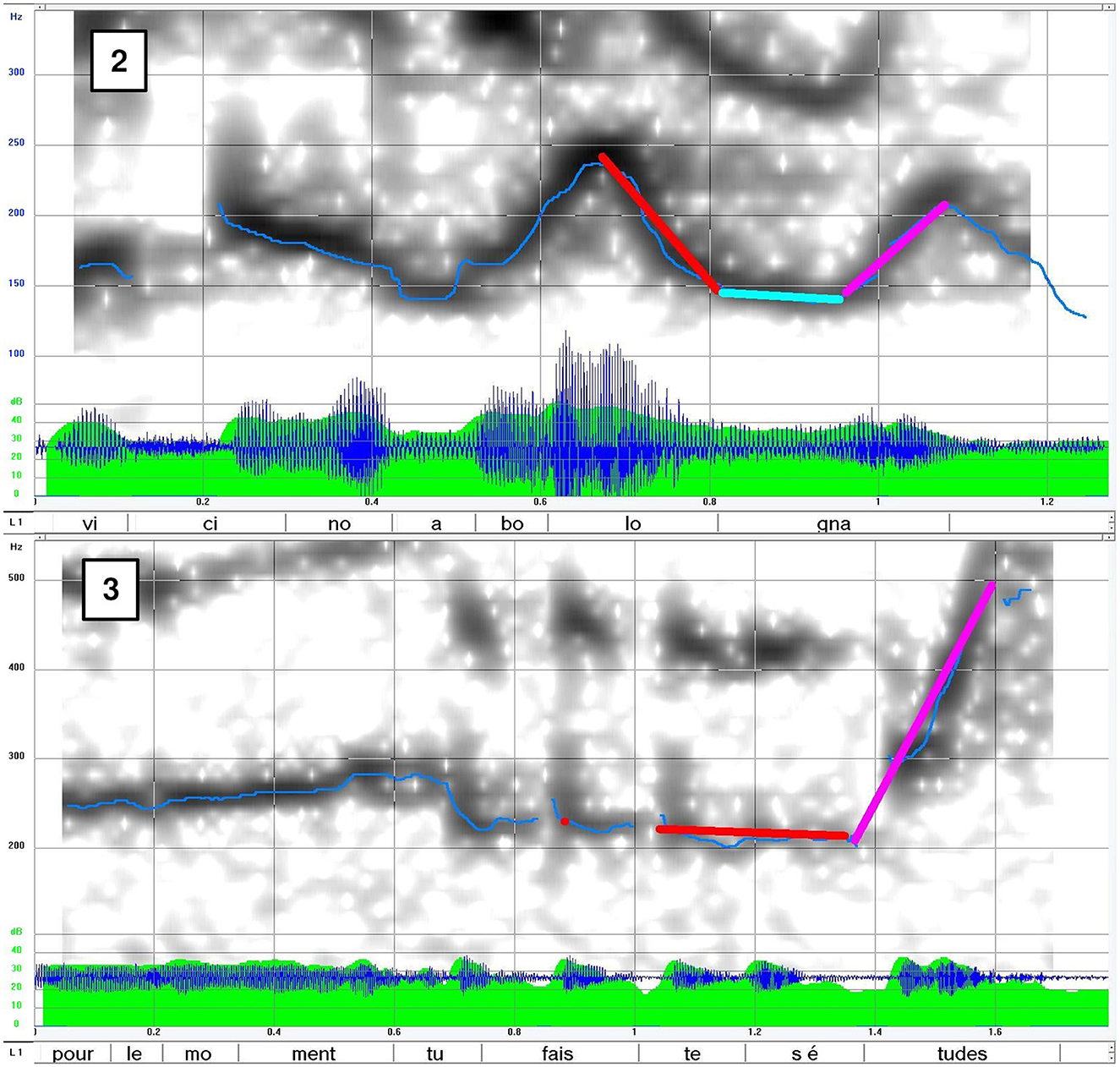
Figure 4. Prototypic contours of Requests for confirmation in Italian and French (2; 3) (Supplementary Audio 2.wav).
The French example in (3) fits with the same pragmatic description. MAR, a young man, explains that he is trying to become an artist. SOP hypothesizes that MAR is doing something useful in the meanwhile and asks for confirmation. According to the description reported in previous literature, the prosodic movement of (3) in Figure 4 corresponds to a rising contour in its high f0 level, aligned to the last vowel, necessarily tonic in French.
(3) *MAR: j' essaierai tout / pour y <arriver / de toute façon> //
*SOP: <ouais donc> pour le moment tu fais tes études ? #
*MAR: ouais // [ffamdl04]
[MAR: I'll try everything, to succeed, anyway. SOP: yeah, so are you currently studying? MAR: yeah.]
There are variants of the f0 range in prosodic contours in Italian and French. However, they bring only attitudinal meanings with no changes in the illocutionary type. For instance, in (4) and (5) MAR, the same French speaker of (3) performs the two questions with a rising contour at a lower f0 range (still over the glissando threshold).
Both questions may be, in principle, biased. In (4), a negative presupposition is probable—it is pretty challenging to be published for a young artist—while in (5), a positive presupposition is more probable—young artists get supported by the group of pairs. The f0 of both examples, reported in Figure 5, shows a final rise at a lower range than in Figure 4. The choice to perform an RC at a lower f0 range may convey mitigation in the force of the request connected to a courtesy attitude (Moraes and Rillard, 2014).
(4) *MAR: [...] ben essayer justement d' écrire des [/] écrire des [/] des textes andeuh essayer de les envoyer / à des producteurs / andeuh voir un peu ce qu' ils en pensent quoi // […]
*SOP: que oui // que ça intéresse quelqu' un ? [ffamdl04-161]
[MAR: well, I try to write texts, I try to send them to producers to see what they think about it. SOP: yes, is anyone interested?]
(5) *MAR: […] on fait des trucs / et puis après ben / on est coincé / on a plus de [/] de pouvoir d' agir quoi // ça c' est clair // c' est un phénomène de société / ça //
*SAN: dans votre mouvement / andeuh justement andeuh est-ce que vous avez été qu and même soutenu ? <par les par les jeunes> //
*MAR: <ah ben oui on est soutenu hein> // [fpubdl01]
[MAR: we do some stuff, and then afterwards well, we're stuck, we have more power to act, what. That's clear. It's a phenomenon of society. SAN: in your musical movement, justly, did you get anyway support? By young people. MAR: ah well, yes, we are supported.]
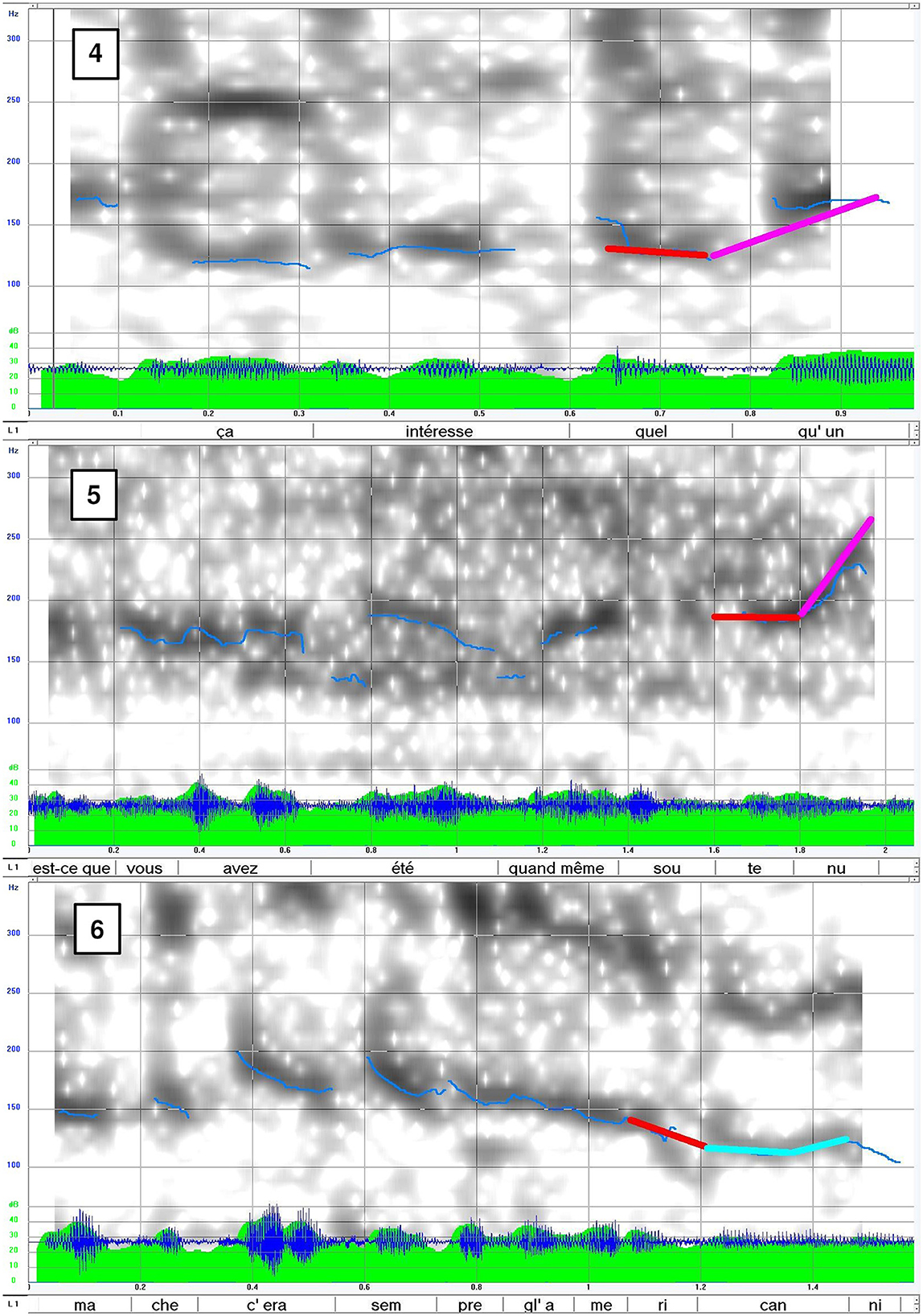
Figure 5. Prosodic variants of Requests for confirmations in French and Italian (4–6) (Supplementary Audio 3.wav).
In the Italian example (6), ELA, the same speaker of (2), asks for confirmation of her hypothesis that American soldiers were still in the country at the end of the second world war. The presupposition is probable as in (2), but the valley profile, marked in Figure 5, is performed at a much lower f0 range. Its perceptual relevance is confirmed by the glissando values of each movement (falling and rising over the glissando and holding under the glissando). Keeping the illocutionary value request for confirmation, we can still perceive that the choice manifests the speaker's courtesy attitude toward the addressee.
(6) *ELA: […] alla fine / della guerra //
*LIA: sì / insomma / c'era sempre un po' // sì / sì // […]
*ELA: ma / che c' era sempre gli americani / <ancora> ?
*LIA: [<] <sì> // quello sì // [ifamcv01]
[ELA: at the end of the war. LIA: yes. Well, there were still some (soldiers). Yes, yes. ELA: but there were always the Americans, yet? LIA: yes. That yes.]
The connection between attitudinal meanings and prosodic cues has been proposed to explain prosodic variations of questions found in corpus-based research beyond the Italian and French traditions. Kohler (2004), in his research on German syntactically marked questions taken from the Kiel corpus, finds a default correlation between the rising prosodic contour and the syntactic structure marked by the verb in the first position (Total questions) and the falling contour and the syntactic structure marked by wh- variables (Partial questions). In his proposal, the two prosodic contours bear different attitudinal meanings: the rising one expresses an orientation toward the addressee with interest and openness toward him, while the falling is oriented toward the speaker and asks for a response.
Dealing with the prosodic variation of syntactically marked questions (Total and Partial) in the corpus, he makes the hypothesis that during communication, the default link can be restructured, and each syntactic type can be found with the not-expected contour, because of the change in the relationship with the attitudinal meaning. Therefore, according to Kohler, the prosodic contour is a function of attitudinal meanings that apply to syntactic constructions.
The L-AcT perspective assumes that prosody is the direct manifestation of the illocutionary enactment, i.e., the prosodic contour is a function of illocution, which in turn shapes syntax. It is worth remembering that nearly 30% of utterances in spoken Romance languages are verbless (Cresti and Moneglia, 2005), and their pragmatic interpretation only results from the prosodic performance. The attitudinal meanings concern spheres of subjective (uncertainty, aggressiveness, and seductiveness) or social connotations (courtesy and social role), that can change the range of f0, speech rate, and quality of voice of a prosodic contour without altering its holistic form and the illocutionary value (Mello and Raso, 2012).
In the case just seen, the valley contour correlates with the illocutionary type of Request for confirmation. The f0 range of the contour can be at a lower level depending on courtesy attitude, but if the form changes, as we will see below, this is a function of the illocutionary type performed.
In conclusion, our corpus data does not verify the variation of a contour in correspondence either with a positive or negative presupposition (bias) (Savino, 2012; Vanrell et al., 2013; Portes, 2020) or with attitudinal nuances. On the contrary, the prosody is sensitive to the hypothesis made by the speaker that determines the valley form in Italian and the rising in French, performing RCs.
3.1.2. Challenging questions
The occurrence of questions in spoken French bearing a rising-falling movement (implicative) on the last tonic syllable has been noted by Fonagy and Brerard (1973) and Rossi (1999). Because of their prosodic closeness, they have been referred to as declarative questions or even peremptory assertions.
The so-called nuance of the meaning of these contours has been the topic of corpus-based and experimental research in French (Portes and Lancia, 2017; Portes, 2020), and similar research has been conducted in Italian and English (Cresti and Moneglia, forthcoming; Rossano, 2010; Hedberg et al., 2017).
Corpus data are a significant source of information to characterize the pragmatics/prosody relation within Total questions. Both in Italian and French, we found recurrent pragmatic patterns which must be distinguished from those conveyed by RCs that are performed through a mountain contour.
A first pattern occurs in dialogic contexts in which the speaker repeats or reformulates a previous addressee's assertion in the immediate precedent dialogic turn or picks up in the common ground the object/argument of the question. For instance, in (7), f0 contour in Figure 6, while talking about the Cuban revolution, DAM questions a circumstance (à douze)—indeed, 12 people starting a guerrilla is remarkable—which DAV has just recalled.
(7) *DAV: donc ils ont débarqué avec andeuh un minimum d' armes / une douzaine / dans un endroit complètement pourri / des marécages // […] et puis ils ont organisé la révolution / là dans les montagnes / à douze //
*DAM: à douze ?
*DAV: à douze // [efamdl10]
[DAV: so, they landed with a minimum of weapons, a dozen, in an entirely rotten place, swamps. [...] and then they organized the revolution, there in the mountains, at twelve. DAM: at twelve? DAV: at twelve.]
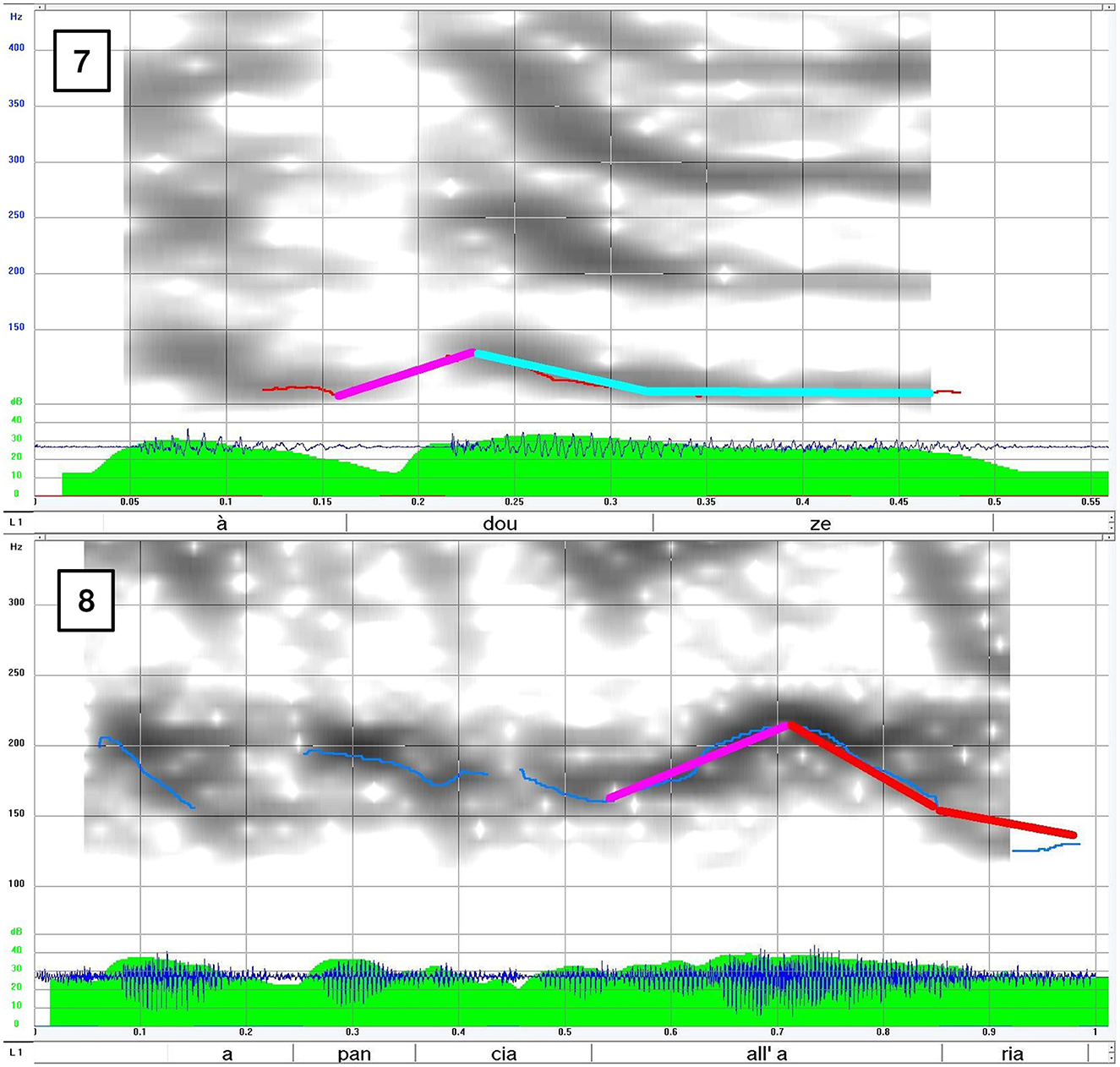
Figure 6. Prototypic contours of Challenging questions in French and Italian (“Validation Pattern” 7; 8) (Supplementary Audio 4.wav).
In (8), f0 track in Figure 6, ELA reformulates the typical position of a happy cat—showing his belly—roughly recalled by LID.
(8) *LID: […] gli facevo / Pallino / Pallino // avanti ha fatto / fr fr ha girato / va' // poi s' è messo / a schiena 'n su / e come ands / si gongolava // tu vedessi<buffo> //
*ELA: [<] <cioè> /a pancia all' aria ?
*LID: a pancia all' aria // [ifamdl02]
[ LID: I called him: Pallino, Pallino. Before he did: fr fr. He turned, finally. Then, he put himself to his back ’n up and gloated. You should have seen how funny it was. ELA: you mean: belly in the air? LID: belly in the air.]
In the above contexts, the information questioned is immediately at the disposal of the addressee. Crucially, the question is not supported by any speaker's hypothesis. In no circumstance, the above context can be paraphrased as the speaker makes the hypothesis of the occurrence of the given eventuality, asking the addressee for its confirmation. In other words, corpus data, both in Italian and French, positively show that this kind of Total question lacks the necessary intentional preparatory condition we identified in RC.
We can describe the pragmatic activity considering that the speaker assumes what is said (or is emerging from the context) and challenges the addressee to validate it through his linguistic behavior as an intersubjectively shared assumption. The act may be peremptory in connection to the greater or lesser speaker's interest in validating the ongoing linguistic exchange.
Even this kind of Total question cannot be defined as seeking for information acts since the information is at the disposal, and the speaker wants just a guarantee. We refer to them as Challenging questions (CHQ).
All questions sharing this pragmatic pattern, both in the Italian and French corpora, show a rising-falling contour which we holistically call mountain—in parallel to the term valley. It corresponds to a complex contour composed of a rising movement (over the glissando) and a rapid falling movement to the baseline (over the glissando).11 Movements are by preference, aligned to the tonic vowel, or the falling movement can be placed on the post-tonic, as in the examples (9) and (10) below. The contour may be followed optionally by a holding movement on words after the nucleus within the root unit.
In parallel, no Total questions, performed in French through a rising contour or in Italian through a valley contour, have been found in pragmatic contexts lacking the speaker's intentional feature hypothesis on the eventuality.
Thus, positive corpus data corroborate the suggestion that the variation of the prosodic contour of the Total question is at least sensitive to the existence or not of an underlying hypothesis by the speaker, leading to differential pragmatic activities (RC or CHQ).
However, in Italian and French, a set of Total questions with a rising-falling contour does not entirely match the previous pragmatic description, i.e., challenging the addressee to validate information already given as a shared assumption. Nonetheless, it is also confirmed in these pragmatic contexts that the speaker does not make any hypothesis on what is asked.
These are probably those language usages that led authors such as Riegel and Pellat (1999) to propose the term injunctive questions. The (9) and (10), f0 tracks in Figure 7, are good examples:
(9) *NIC: [<] <ne ho fatte> tre //
*CEC: posso averne una ?
*NIC: sì // [ifamdl17]
[NIC: I made three (pictures). CEC: can I have one? NIC: yes.]
(10) *UBR: […] pour les groupes et les cars / c' est seulement trente-huit francs //
*PEL: oui c' est assez cher // et nous sommes obligés d' inclure le prix dans / notre produit de la journée // andeuh est-ce que on peut voir un choix ? [fpubdl02]
[UBR: For groups and coaches, it's only thirty-eight francs. PEL: yes it's quite expensive. And we must include the price in our ticket of the day. Can we see anything else?]
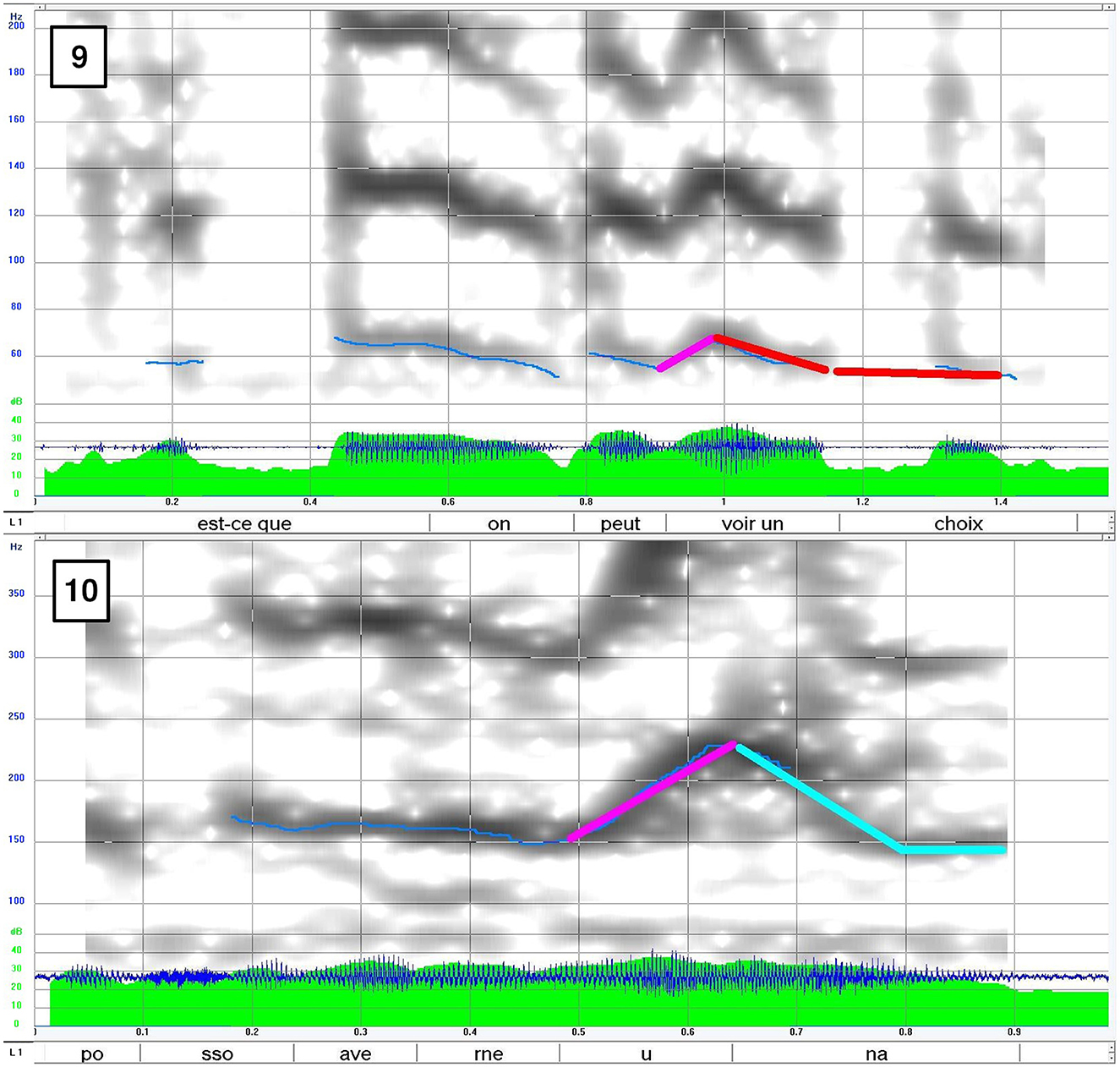
Figure 7. Prototypic contours of Challenging questions in French and Italian (“Injunctive Pattern” 9; 10) (Supplementary Audio 5.wav).
In (9), NIC wants permission from his brother to keep a picture as a sign of affection. In (10), PEL pushes the seller to offer a different tour. Both utterances challenge the addressee by bearing a strong directive force instead of making a hypothesis. The answer is strongly requested to the addressee, and the interest of the speaker on the matter is even higher than in the validation context, thus fitting well with the term Challenging questions.12
The specific goal of Challenging questions varies and does not define the language activity. In (7) to (10), the speaker wants to validate a piece of information as a shared assumption; in (9), the interest is relative to the speaker's behavior (to keep the picture), and she asks for permission (linguistic behavior by the addressee). Conversely, in (10), the interest regards an action to be performed by the addressee13.
The pragmatic similarities between Challenging question groups may be summarized as follows:
• The speaker does not make any hypothesis or assumption on the proposition.
• The speaker challenges the addressee with force.
• The interest of the speaker in the question is high.
In conclusion, Total questions find two main prosodic contours in Italian and French. The prosodic variation is sensitive to pragmatic features such as the presence or lack of the intentional preparatory condition regarding the speaker's hypothesis on one side and the force of the challenge toward the addressee on the other. If the hypothesis is present, the force is weaker, and the question enacts a Request for confirmation. If there is no speaker's hypothesis and the force is strong, the question enacts the Challenging illocutionary type. Prosody varies accordingly.
3.2. Partial and open questions
3.2.1. Italian partial and open questions
Partial questions can be defined as those interrogative utterances whose scope is a variable expected to be saturated in the answer. In Italian, they represent nearly 38% of questions. Their syntactic structures correspond mostly to verbal phrases that the Wh- interrogative morpheme precedes (chi, che cosa, quale, dove, quando, quanto, come, perché, and come mai)14. The morpheme can occur alone or at the beginning of the Comment unit.
Partial questions are properly seeking information acts and do not imply any hypothesis by the speaker on the proposition satisfying the query.
The prosody of Partial questions is a falling contour (over the glissando) starting on the tonic vowel of the variable, which can be characterized by a more or less rapid declination, depending on the height at the start, the length of the information unit, the speed of speech, and sometimes on stance. See, for instance, two WH questions performed by female speakers. (11) is introduced by dove (where) and is characterized by a neutral attitude. The falling movement, reported in the f0 track of Figure 8, starts at a middle height and declines slightly.
(11) *ELA: n' dove l'è ? [ifamcv01]
[ELA: where is it?]
(12), still showing a falling movement, is more lengthened and starts from higher f0 values. The question seems characterized by an attitude of insistence.
(12) *EST: quando parte? [ifamdl15]
[EST: When does she leave?]
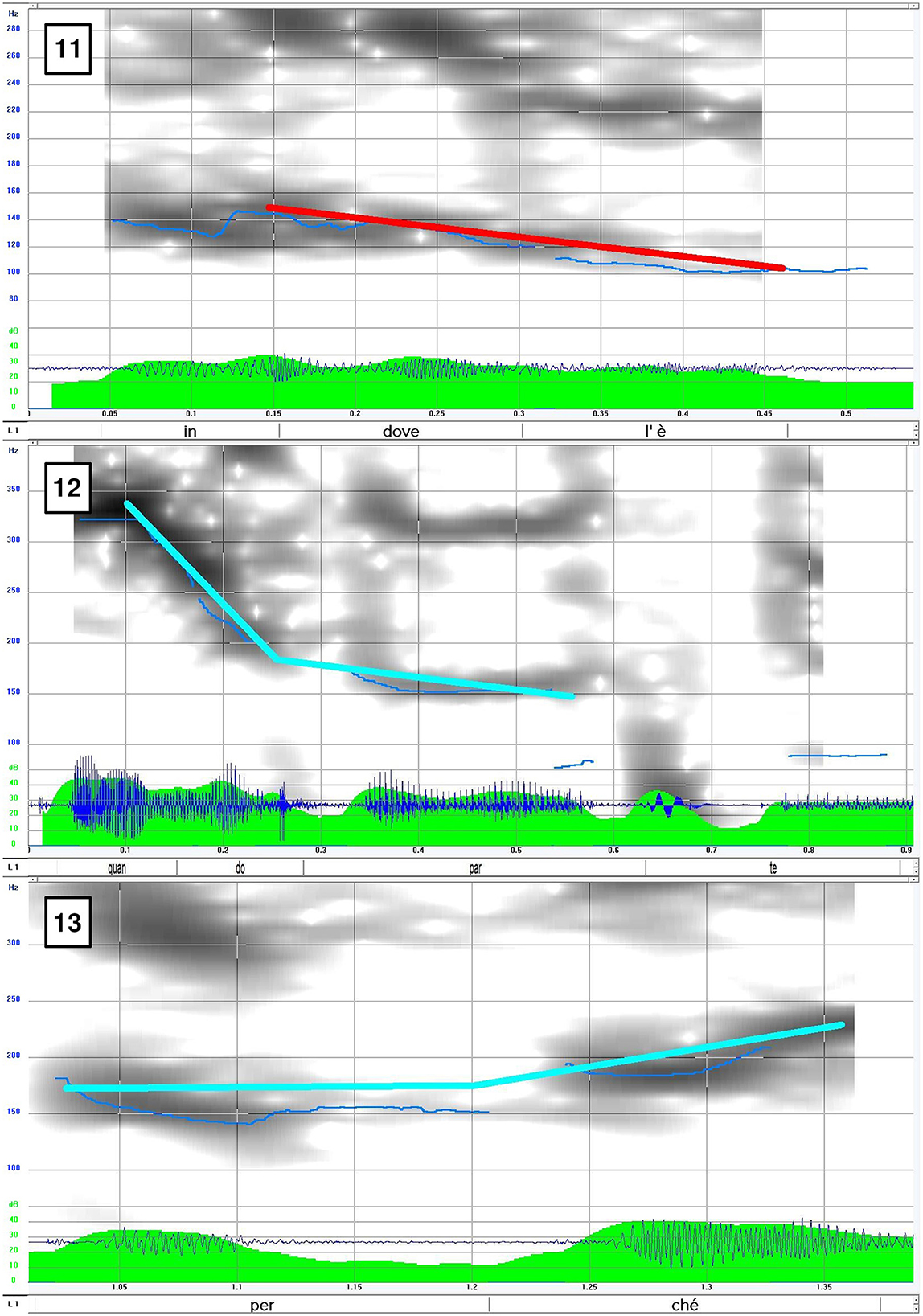
Figure 8. Prototypic contours of Partial questions in Italian (11–13) (Supplementary Audio 6.wav).
In Italian, the only prosodic difference within Partial questions regards the performance of perché (why). In (13), this variable is realized through an upward movement that can be slightly rising (over the glissando), as in Figure 8. 15
(13) *ELA perché? [ifamcv01]
[ELA: Why?]
Perché frequently occurs in isolation; however, other words can follow it, taking part in the question as a tail with no functional value. From a pragmatic point of view, perché questions are distinguished from other WHs because of their prosody and because they are expected to be saturated by an explanation rather than a noun or prepositional phrase.
The idiosyncratic prosodic performance of perché allows passing to the description of Open questions (OP), which is rarely considered in previous literature (Weisser, 2018). Its syntactic structure corresponds to a verb-less phrase (noun phrase, adverbial phrase, adjectival phrase, and verb nominalization) filling the Comment unit (13% of PQs).
In (14), f0 track in Figure 9, PAO performs a question (per quest'estate?), showing a continuous rising contour aligned to the last tonic vowel (over the glissando), optionally followed by holding movement on the post-tonic.
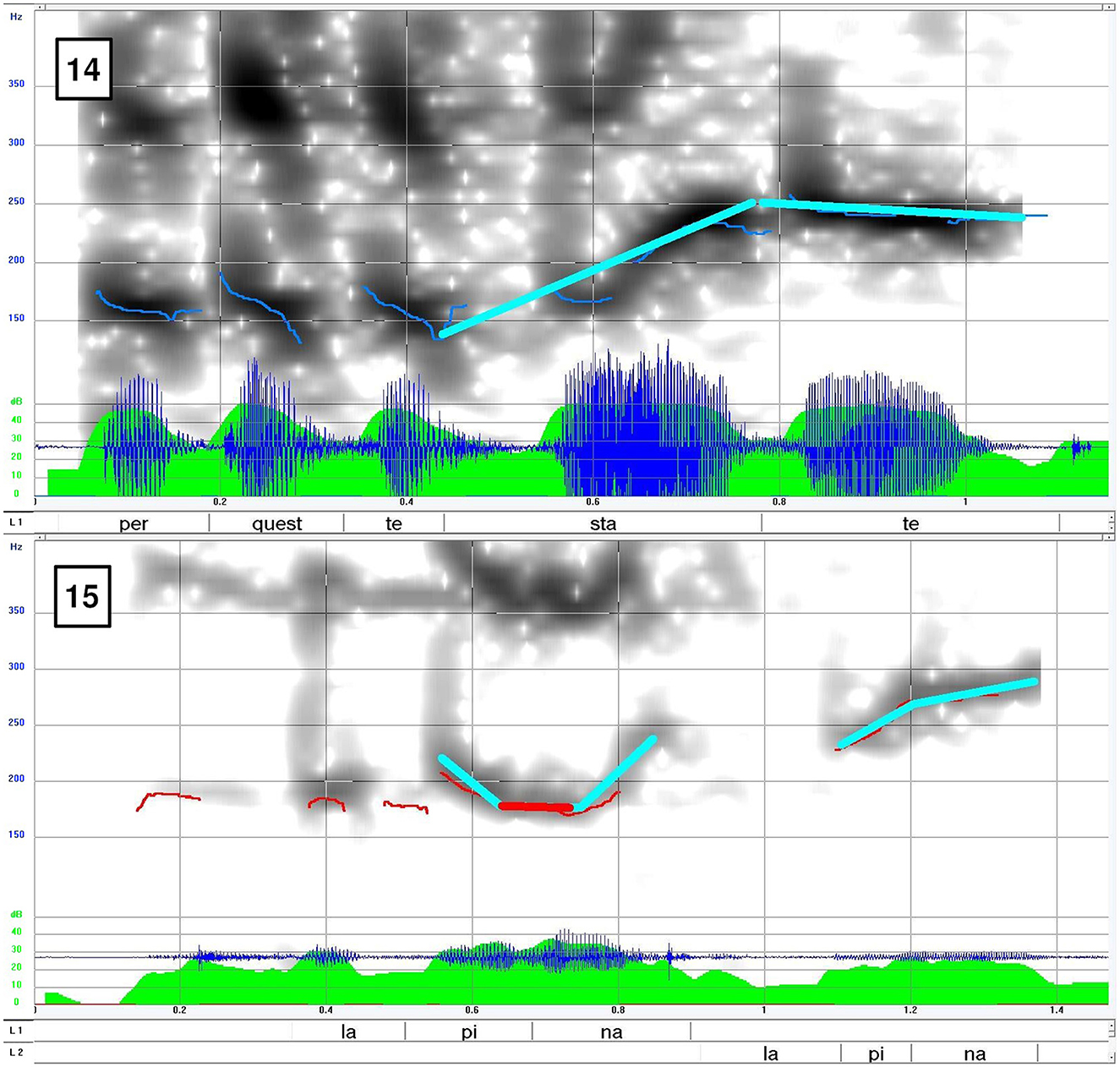
Figure 9. Prototypic contours of Open questions in Italian (14; 15) (Supplementary Audio 7.wav).
Although the question does not specify precisely what kind of answer is expected, it just seeks an explanation. The addressee cannot answer Y/N.
(14)*PAO: perché la domenica / tu se' qui / a < negozio> //
*FRA: da urlo //
*PAO: ma / anche / pe' quest' estate ? come / tu se' messa ? [ifamdl12]
[PAO: because on Sunday, you are here, at the store. FRA: screaming. PAO: but, and for this summer? how do you manage it?]
In (14), “for this summer” might be considered the topic of the Partial question, “how do you manage it?”. But this is not the case since the first phrase bears an illocutionary force, and it is a Comment that can be interpreted as an independent question. The difference is reflected in the prosodic performance since OPs, as in the prototype in Figure 9, show a continuous rising contour.
The continuous rising contour distinguishes from valley and mountain contours of the Total types and resembles the one found with perché. Maybe not by chance that perché too foresees an explanation as an answer.
OPs are filled by a verb-less phrase, as is frequent in Total questions but cannot be answered by Y/N. The only reason for it can be up to their specific prosody. For instance, (15), f0' tracks in Figure 9, shows that the two prosodic contours on the same proper name (la Pina) determine their different pragmatic interpretations. CLA wants to hear about a girl whose name she does not remember well. EST assumes that she is named Pina performing a Request for confirmation. CLA asks an open question on this subject.
(15) *CLA: <e quella> ragazza / < la> …
*EST: <la> Pina ?
*CLA: la Pina ?
*EST: eh // lei / prima veniva tutte le settimane // [ifamdl15]
[CLA: and that girl, the. . . EST: Pina? CLA: Pina? EST: eh. She used to come every week.]
The different contours of the same lexical word can be easily compared. While the first utterance shows the typical valley of RC, the second, the OP, is performed through a continuous rising contour.
The pragmatic function of OP can be summarized in the following conditions: a) as all WH, the question does not convey a speaker's hypothesis; b) it is genuine seeking for information activity; and c) it waits to be freely completed by the answer.
3.2.2. French partial and open questions
In French data, Partial questions represent nearly 26% of the total amount and are composed of the whole range of Wh- morphemes (comment, où, quand, quel, quoi, combien, pourquoi) but can also be headed by q'est-ce que/qui.
Wh- morphemes are distributed not only at the beginning of the Comment unit, as in Italian, but also in situ at its end and (only occasionally) within it. The most frequent distribution is at the beginning (nearly 65%) and only 25% is at the end. However, it must be stressed that the initial position is filled in 45% of cases by q'est-ce que/qui, lequel, quel/quelle, and pourquoi, that in our data do not find any other position. Therefore, the remaining Wh- variables are distributed fifty/fifty in the initial and final positions, which is prominent.
When the interrogative morpheme occurs at the beginning of the Comment, its prosodic performance corresponds to a slightly falling contour (over the glissando) starting from the tonic vowel of the Wh-. A slightly rising tail can optionally complete the movement, as in the f0 track of (16) in Figure 10.
(16) *MIR : qu'est-ce qu'elles deviennent maintenant ? [ffamdl17]
[MIR: what they become now?]
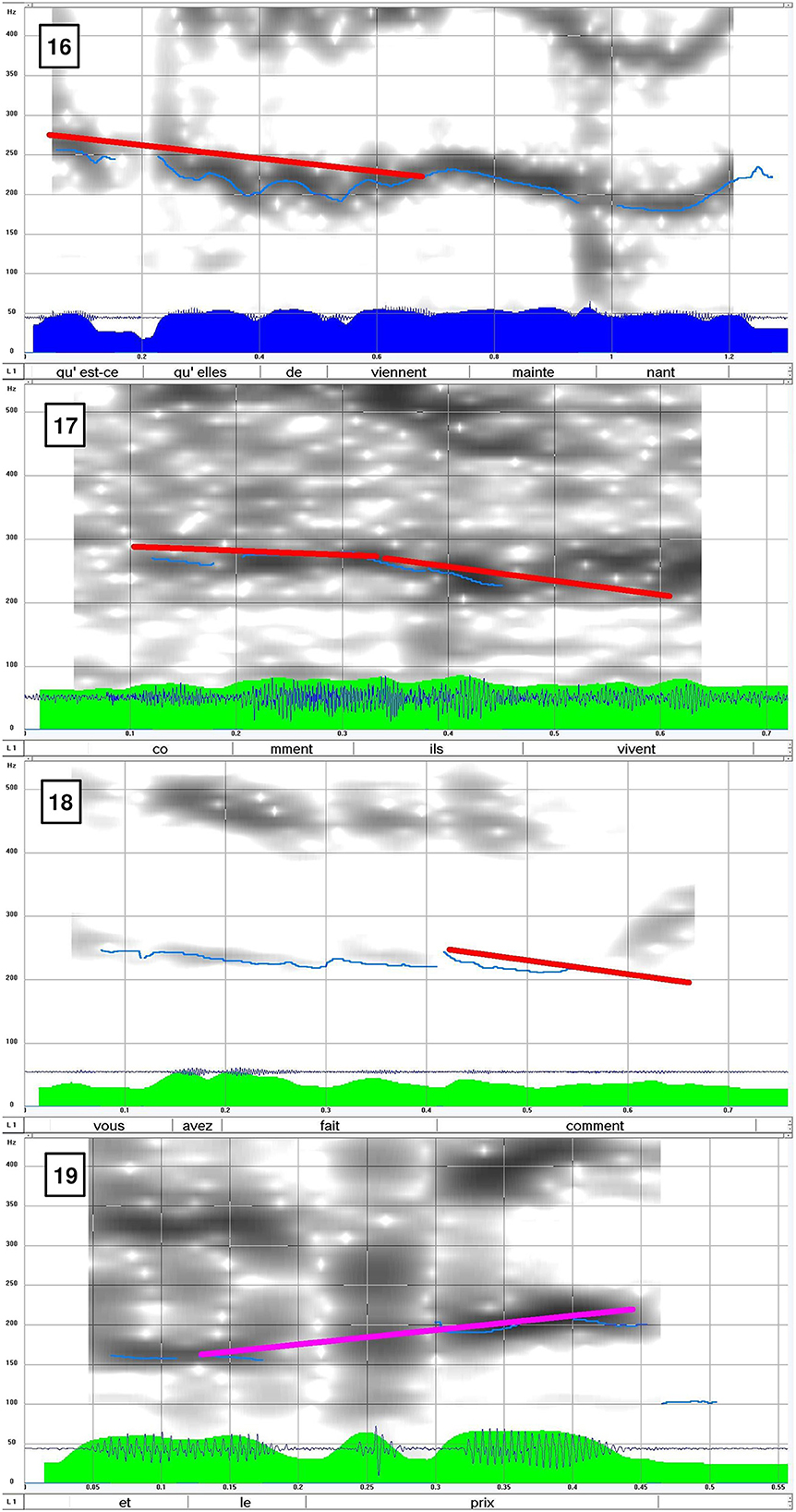
Figure 10. Prototypic contours of Partial questions and Open questions in French (16–19) (Supplementary Audio 8.wav).
In (17), the prosodic contour of the most common Wh- morpheme (comment), distributed in the first position, is consistent with this description (f0 in Figure 10).
(17) *SAN: comment ils vivent ? [ffamdl02]
[SAN: how do they live?]
When the interrogative variable is in situ, the contour is nearly flat or weakly rising on the morpheme, marked by a minimal reset, strong intensity, and/or lengthening (still over the glissando). The f0 track of example (18) shows how prosody works on “comment”.
(18) *JOS: vous avez fait comment ? [ffamcv05]
[JOS: did you do it how?]
Open questions also occur in French (13.7% of PQs). Their syntactic structure is verbless phrases. The question is expected to be freely completed in the answer by an explanation, as in Italian. Their prosodic performance is a continuous rising contour (over the glissando). It can be only roughly compared to the Italian prosodic performance, as verified in the f0 track of (19) reported in Figure 10.
(19) *UBR: euh je vous garantis que andeuh [/] qu'avec ça / vos clients auront passé / une journée mais alors vraiment mémorable hein //
*PEL: et le prix ?
*UBR: andeuh le prix / andeuh /deux cents francs tout compris // [fpubdl02]
[UBR: uh, I guarantee that that with this, your customers will spend a day but then really memorable, eh. PEL: and the price? UBR: uh, the price, uh. Two hundred francs all inclusive.]
3.3. Questions as illocutionary patterns in Italian and French
3.3.1. Tag questions
Double questions, Alternative questions (both positive and negative), and Tag questions are performed within Illocutionary pattern structures, which require the distribution of the utterance in two pragmatic units (CMM) in a prosodic pattern. All types are well documented in both corpora (from 9 to 15% of questions) and vary similarly in the two languages, as pies A and B of Figure 11 show. 16
In Italian and French, Tag questions are composed of a first assertive CMM, shaped according to the prosodic variation allowed by the assertive Illocutionary types (Cresti, 2020), and a second CMM filled by a morpheme working as a tag unit. Without the tag unit, the utterance would not be considered a question. The morpheme directs to the addressee the previous assertion, which functions as a positive hypothesis, stimulating him to confirm it. From a pragmatic perspective, Tag questions are almost equivalent to weak RCs.
A restricted number of morphemes can constitute the lexical filling of the second CMM. In Italian: forse, vero, no, eh, and giusto; in French, hein, non, vraiment, and c'est ça. (20) and (21) show Tag questions in the two languages, where the more common lexical expression filling the tag label are, respectively, eh and hein. Their respective f0 track is displayed in Figure 12.
(20) *ELA: Fiordalice / eh ?
[ELA: Fiordalice, isn't it?][ifamdl02]
(21) *EMA: il y en a beaucoup / hein? [efamdl23]
[EMA: there are a lot, isn't it?]
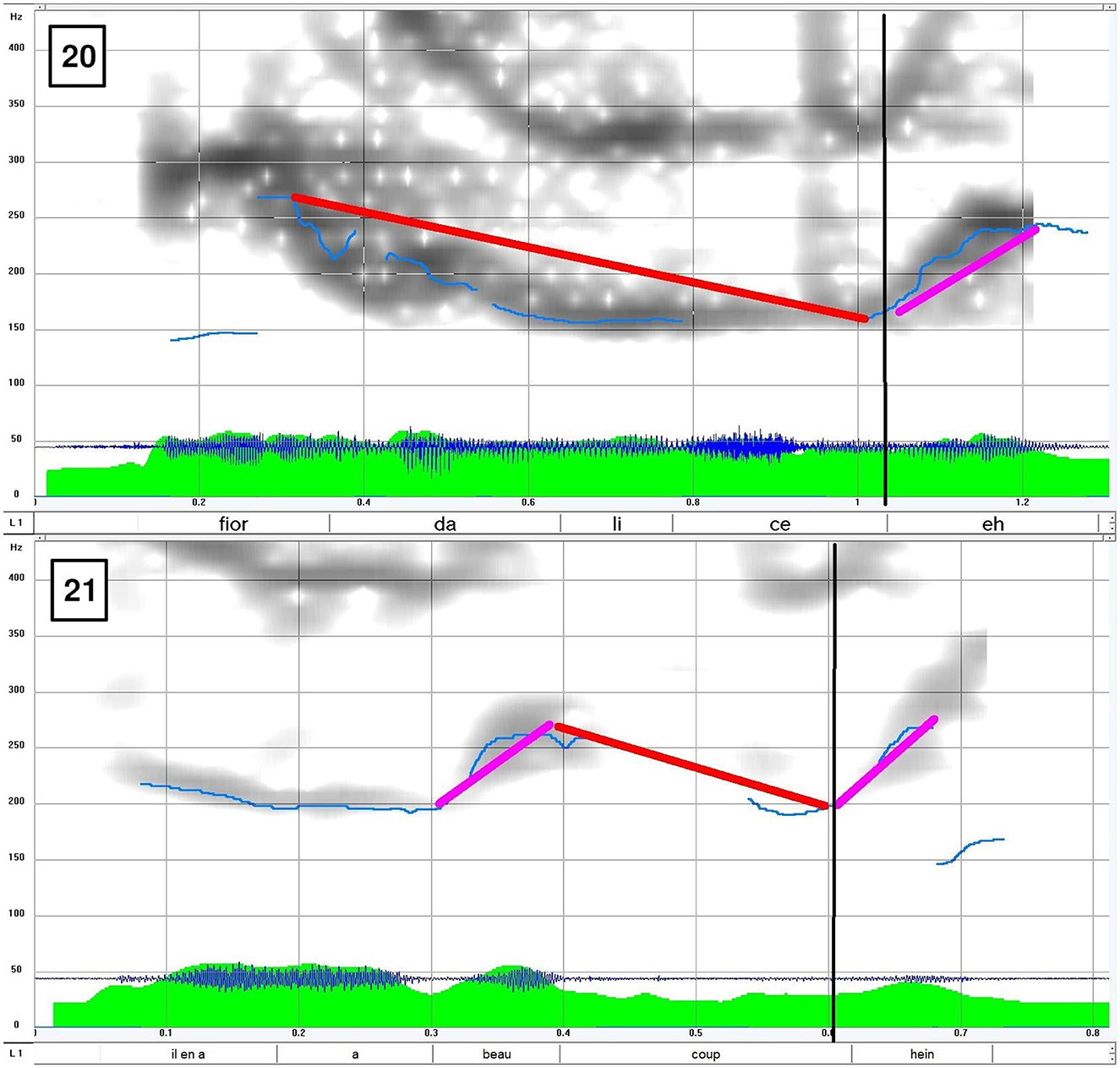
Figure 12. Prototypic contours of Tag questions in Italian and French (20; 21) (Supplementary Audio 9.wav).
Prosody is crucial to enact the illocutionary role, which requires the morpheme to be a stressed vowel rising (over the glissando) or lengthened. This condition can be verified on corpus data. The morpheme eh in Italian and hein in French frequently also play a Phatic function, strengthening the previous assertion's force. In those cases, the morpheme is defocused and is performed at a lower f0 level (under the glissando).
3.3.2. Alternative questions
Half of the Illocutionary patterns in Italian and French are Alternative questions: either positive or negative. (22) and (23) are, respectively, Alternative negative (ANQ) and Alternative positives of the Italian Dataset, while (24) and (25) are comparable French examples. Figure 13 presents their f0 contours.
(22) *GIA: le metto / o no? [ifamcv14]
[GIA: do I put them on, or not?]
(23) *ANT: ma lui è più grande / o più piccolo? [ifamdl05]
[ANT: is he older, or younger?]
(24) *SOP: ça vous dit quelque chose / ou pas ? [fnatte02]
[SOP: does that mean anything to you or not?]
(25) *SOP : c'était d'abord anglais / ou c'était d'abord français ? [ffnatte02]
[SOP: was it English first / or was it French first?]
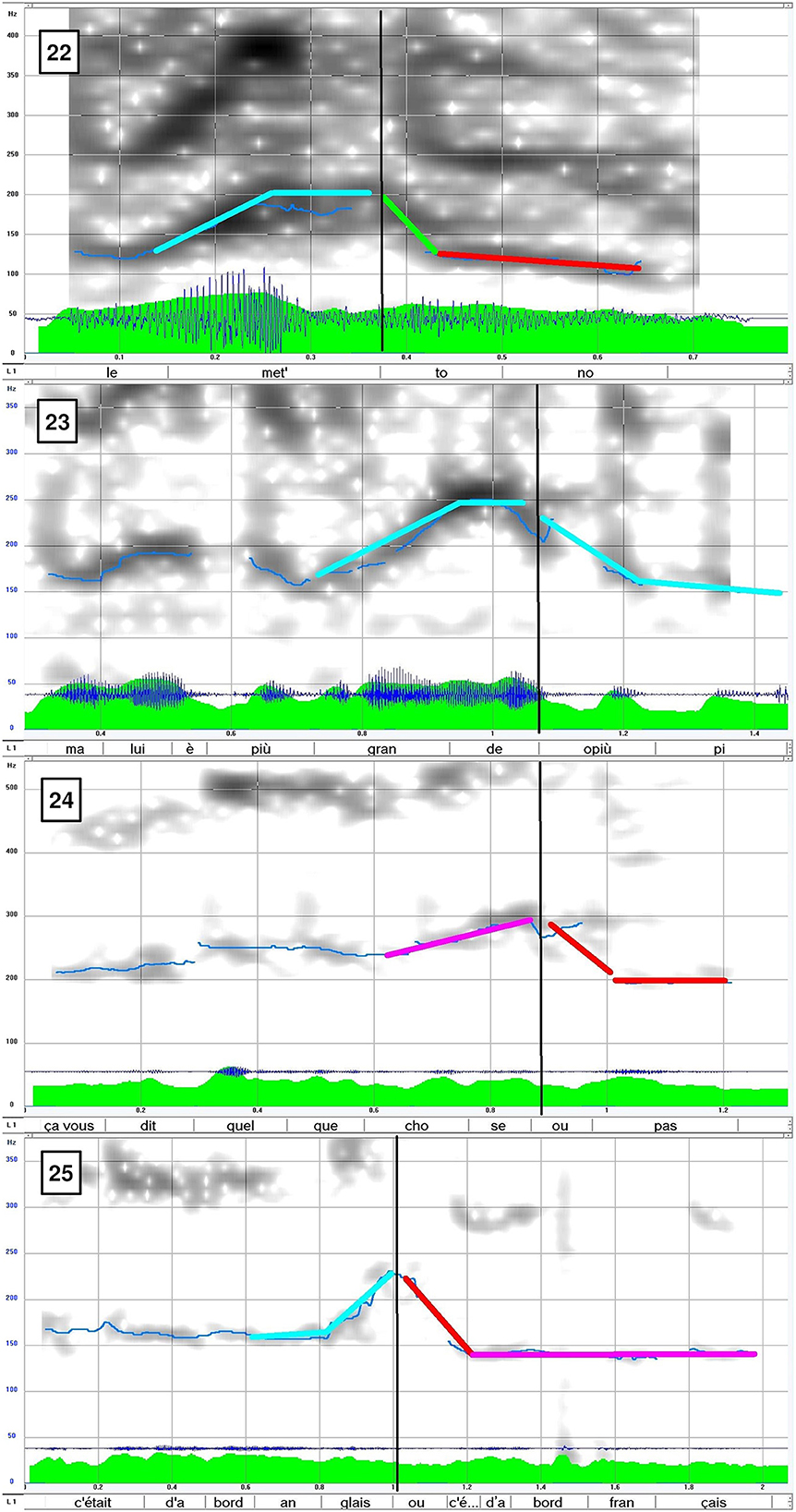
Figure 13. Prototypic contours of Alternative questions in Italian and French (22–25) (Supplementary Audio 10.wav).
In no case, the Alternative patterns are equivalent to the performance of one sole question since the interpretation of the utterance does not concern a question on the truth of disjunctive coordination, as it might be in “is it true that (chess pieces are white or black)?”.17 Each CMM bears an illocutionary force of question, but the actual request is up to their association within the pattern, even if, as sometimes happens, the disjunctive conjunction (or) is not realized.
APQ and ANQ have different semantic values. In ANQ, one sole proposition is questioned and, for this reason, can be answered Y/N. On the contrary, APQ requires a choice between two propositions and cannot be answered Y/N.
ANQs work as a Total question; if the answer is negative, the question is solved. In contrast, the positive response is insufficient and requires supplementary information. Although APQs cannot be answered Y/N, a negative answer is possible, but it denies both possibilities and is by preference integrated by additional information.
From a prosodic point of view, quite surprisingly, APQ and ANQ show the same prosodic pattern, which is also the same in Italian and French. The first CMM bears a rising movement (over the glissando) with a peak on the final tonic vowel. In Italian, the rising contour is followed by a hold (under the glissando) if the word is paroxytone. The second CMM bears a level contour composed of rapidly falling on the first tonic vowel, followed by a holding movement at low f0 values (over the glissando) spread on the subsequent syllables. This description roughly replicates the prosodic description of alternative constructions in French (Delais-Roussarie and Turco, 2019).
Although the semantics of alternative questions might be extensively treated, from corpus data that emerge on the pragmatic ground, both APQ and ANQ, to be meaningful, cannot imply a hypothesis by the speaker on the questioned alternative and cannot be interpreted as RC but rather function as CHQ.
3.3.3. Double questions
Although virtually ignored in Italian or French grammar, Double questions (DBQ) are well testified in language usage. As with the other Illocutionary patterns, they split the question into two prosodic contours (CMMs). They were described by Fonagy and Brerard (1973) as a double-rising movement belonging to the same prosodic contour. They report that Dubois already considered it like a prosodic redundancy on a unitary content that could constitute a single interrogative sentence. However, this description does not fit with the speech performance since each CMM signals a distinct act.
Italian and French DBQ present different types. Still, the overall structure always consists of a first CMM performing a question and a second CMM restricting the first. For instance, French features Double patterns with either a WH or a Total question in the first CMM, as in (26) and (27).
(26) *MAI: vous avez fait quoi / ce week-end ?
[MAI: what did you do this weekend?] [ffamcv05]
(27) *SAN: vous êtes nombreux / là ?
[SAN: there were many of you, there?] [fpubdl01]
From a prosodic point of view, the contour of the WH is strictly compatible with the overall WH model, showing a prosodic marking of the Wh- variable, which is placed mainly in situ, as the f0 track of (26) in Figure 14. The second CMM shows a level contour (over the glissando) spread over the sequence of syllables. The answer should satisfy the Wh- variable.
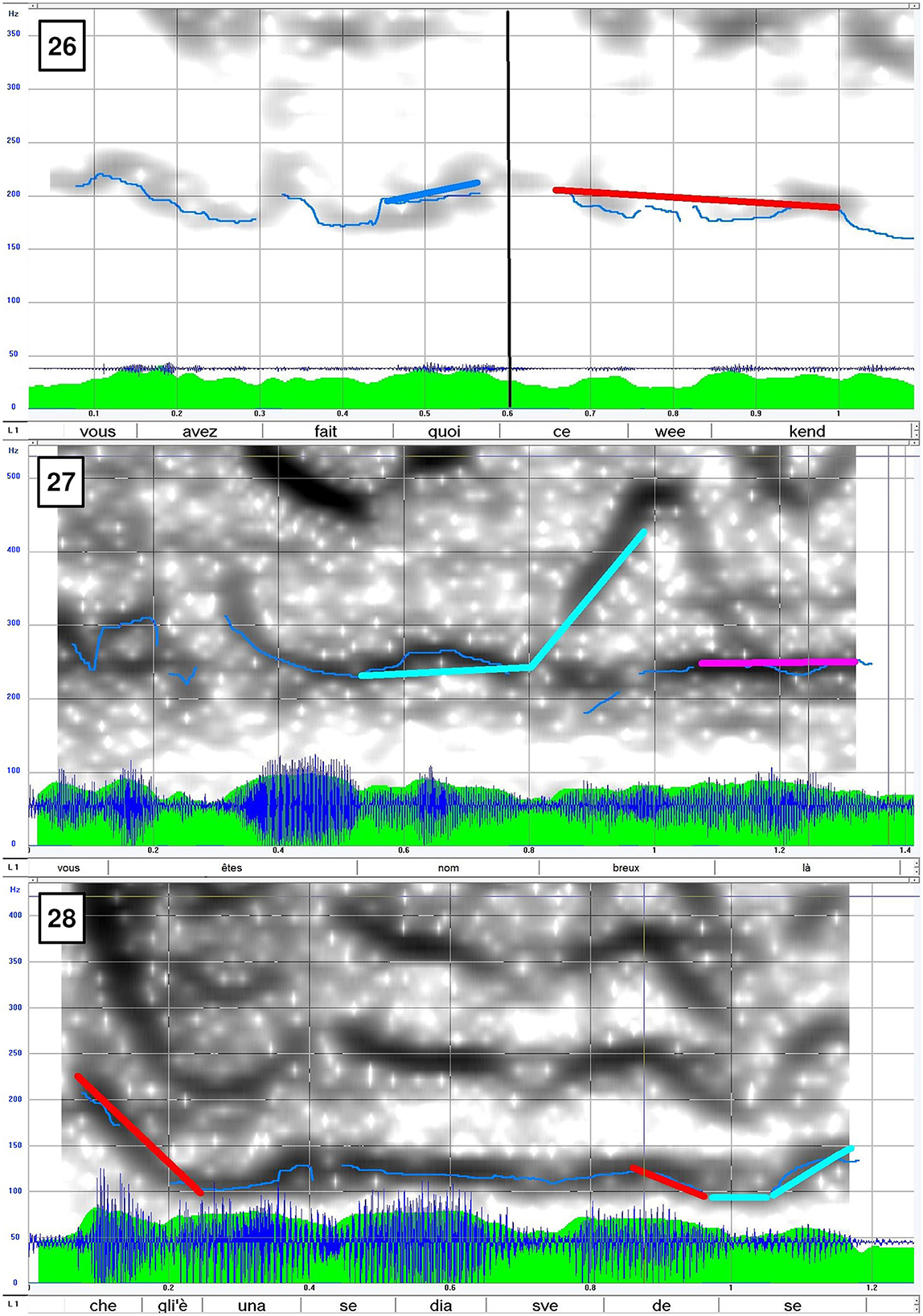
Figure 14. Prototypic contours of Double questions in French and Italian (26–28) (Supplementary Audio 11.wav).
The prosodic pattern of (27), displayed in Figure 14, corresponds to the sequence of a rising contour on the last vowel, strictly compatible with French RCs in the first CMM and a level contour (still over the glissando) in the second CMM, as in (26). The answer is necessarily Y/N.
It is worth noting that it is hard to interpret the second CMM as an autonomous question. However, the unit is not defocused as it might be the case, in the L-AcT perspective, for an Appendix of Comment (Cresti, 2021). As Martin (2008, 2018) noticed discussing similar questions within the Macro-syntactic approach (Blanche-Benveniste, 1997), the second unit of a DBQ works as a postfix. It must be distinguished from both an independent noyau and a suffix unit. In other words, the high-level contour bears a functional value in French, working as a specification act within the Illocutionary pattern.
DBQ in our Italian sampling always corresponds to a first CMM performing a WH question, followed by a second CMM restricting its scope.18 Let us see (28).
(28) *POL: che gli'è / una sedia svedese?
[POL: what is (it), a Swedish chair?] [ifamcv27]
Figure 14 shows that the prosodic contour in the first CMM of (28) is falling, matching the Italian WHs. In contrast, the second CMM fits with the contour assigned to RC (valley), with the falling part (over the glissando) on the last tonic vowel and a hold (under the glissando) followed by a rising (over the glissando) on the post-tonic. In (28), the second CMM saturates the Wh- variable, thus modifying the status of the first WH question, which becomes an RC and can be answered Y/N.
Despite the variation found in DBQ, which may correspond to WH (seeking information) and RC, we never found Illocutionary patterns working as Challenging questions. In other words, the restrictive role of the second CMM develops a mitigation effect.
4. Conclusion
In the L-AcT frame, the pragmatic domain of questions is a sub-class within the overall Direction class and is defined as the speaker's activity aimed at the addressee's linguistic behavior, passing from being considered the speaker's seeking for information activities as corpus-based taxonomies assume, to a more general concept.
Two selections of ~4,000 utterances have been derived from the Italian and French C-ORAL-ROM corpora. Focusing on the Comment information unit, we derived the main prosodic properties of questions in the two languages and their pragmatic correlations.
The first finding is that <10% of utterances are questions in language usage compared to assertive over 50%. The corpus-based study allows sketching the quantitative proportion among the main question types. Total questions (37% FR −39% IT) and WH questions (26% FR −38% IT) are the most frequent type. The relevance of questions performed through Illocutionary patterns (Tag-questions, Alternative questions, and Double questions) is highlighted (9% IT −5% FR).
Beyond the grammatical distinction between Total and Partial questions, the syntax finds little relevance in the typological classification of questions. Semantic aspects, such as positive and negative presuppositions (bias), are not predictive of the pragmatic typology. Total questions, which are expected to be answered by the addressee positively or negatively, and which are supposed to fit standard prosodic models, show a consistent number of instances bearing a so-called declarative contour, respectively 26% in French and 36% in Italian. This is a relevant corpus finding which asks for an explanation.
We provided evidence correlating the two contours with pragmatic values. On one side, the valley contour (in Italian) and the final rising (in French) aim to obtain the addressee's agreement on a speaker's hypothesis, accomplishing a Request for confirmation (RC). Conversely, the mountain contour (in both languages) challenges the addressees (CHQ). Both types depart from the shared pragmatic definition of questions as seeking information acts. The prosodic contours reflect intentional and affective differences, mainly depending on the balance between the weight of the speaker's hypothesis, which only pertains to RC, the interest toward the addressee, and the force of the request, which is highest in CHQ.
Seeking for information activities are limited to Partial questions. PQs are strong requests to the addressee, performed by a falling contour in both languages and, in French, by marking the Wh- variable when in situ. PQs comprise Open questions. OPs show a specific prosodic contour (continuous rising) shared by the two languages and correspond to a vague underlying WH question the addressee is free to satisfy as he prefers.
The Illocutionary patterns are natural rhetorical figures linking two illocutionary units (CMMs) within a prosodic structure. Tag questions manifest the speaker's hypothesis in a first assertive CMM, while the Tag morpheme signals an RC to the addressee. The prosodic pattern corresponds to an assertive contour in the first CMM, followed by a focused rising or lengthened contour.
In Alternatives questions, positive and negative, the content is composed of two pragmatic units put in alternation. In both languages, the prosodic pattern is composed of a rising contour followed by a low-level contour. From a pragmatic point of view, contrary to Tag questions, the Alternative Illocutionary pattern develops a CHQ.
Double questions enact a speaker's way of realizing complex questions that are hierarchically structured: the first CMM always demands to be further specified in the second. This general model is reflected in various types depending on the semantic relations between the two CMMs. Although our description is limited by the small number of Double questions in the dataset, some difference between the two languages has emerged.
In Italian, Double questions are mainly composed of a first WH question performed through a canonical falling contour. The second CMM saturates the Wh- and the Illocutionary pattern works as an RC. In French, we found the first CMM recording either a WH question or a Total question; however, the second CMM always restricts it to a circumstantial argument. Accordingly, the Illocutionary patterns work as a WH or as an RC.
Table 4 summarizes the pragmatic system of activities aimed at the addressee's linguistic behavior shared by the two languages and the differential prosodic contours allowing their performance.
Data availability statement
The original contributions presented in the study are included in the article/Supplementary material, further inquiries can be directed to the corresponding author. For the availability of the complete data set, see footnote 7.
Author contributions
All authors listed have made a substantial, direct, and intellectual contribution to the work and approved it for publication.
Conflict of interest
The authors declare that the research was conducted in the absence of any commercial or financial relationships that could be construed as a potential conflict of interest.
Publisher's note
All claims expressed in this article are solely those of the authors and do not necessarily represent those of their affiliated organizations, or those of the publisher, the editors and the reviewers. Any product that may be evaluated in this article, or claim that may be made by its manufacturer, is not guaranteed or endorsed by the publisher.
Supplementary material
The Supplementary Material for this article can be found online at: https://www.frontiersin.org/articles/10.3389/fcomm.2023.1124513/full#supplementary-material
Footnotes
1. ^The terminology of question illocutionary acts varies in the different tag-sets. To the purpose of clarity, when reporting previous literature, we use the most widespread Y/N label for questions that can be answered negatively or positively and the WH label for questions that satisfy the interrogative variable in the answer. Within our approach, we will use the label Total question for all kinds of Y/N and the label Partial question for all kinds of WH.
3. ^Their identification has been proven consistent across languages reaching a high interrater agreement (Cresti and Moneglia, 2005; Raso and Mello, 2012; Barbosa and Raso, 2018; Panunzi et al., 2020; and references therein).
5. ^Figures report the f0 tracks calculated with Winpitch. Given that noisy signals are frequent in spontaneous speech corpora, we will present the f0 face to the first or second harmonic to verify the correctness of its calculation. The nuclear f0 movements are highlighted in the f0 tracks. One wav. file with the acoustic signals in each figure is delivered. The C-ORAL-ROM file is reported for each example.
6. ^The term valley must be distinguished from the usage proposed, for instance, by Kohler (2004), indicating a simple rising contour with no reference to the necessary previous falling movement on the tonic vowel.
7. ^The dataset is available from https://github.com/labiu/coralrom_questions_it-fr
8. ^Although both genders are represented, the dataset is not settled for dealing with the gender characteristics found in questions (Niebuhr, 2015). Corpus data testify, however, that the correlation between prosodic contours and the speech act types are testified in both female and male speakers recorded in the corpus.
9. ^https://typo.uni-konstanz.de/questionsInterfaces/
10. ^In the absence of corpus examples, it is not clear if this contour can be assimilated to the H* L-H%, as proposed by Grice et al. (2005) and evaluated as the most frequent in Florentine.
11. ^Movements can be characterized by speech rate as slow or rapid (with respect to the rate of the entire root unit).
12. ^Dehé and Braun (2020) consider declarative questions in English as rhetorical because they ask a question to create a dramatic effect or to make a point rather than to get an answer. Thus, they are considered challenging rather than seeking information. In our frame, CHQs genuinely challenge an answer, but cannot be classified as rhetorical for their directive force.
13. ^According to the tradition, (12) can be seen as an indirect speech act, i.e., requests of action by the addressee instead of linguistic behavior.
14. ^The percentage of each single Wh variable is not reported since it is not relevant in such a small dataset.
15. ^Depending on attitudinal connotations, for instance, surprise, it can also reach a higher peak.
16. ^Supplementary instances have been detected in IPIC database which stores the full informal section of C-ORAL-ROM Italian (Panunzi and Gregori, 2012).
17. ^In Weisser's Taxonomy, the Alternative question is foreseen but is composed of only one syntactic unit introduced by the conjunction or.
18. ^The type of DBQ composed of a first CMM with a Total question, as in French, is missing in the Italian corpus.
References
Anderson, A., Bader, M., Bard, E., Boyle, E., Doherty, G., Garrod, S., et al. (1991). The HCRC map task corpus. Lang. Speech 34, 351–366. doi: 10.1177/002383099103400404
Barbosa, P., and Raso, T. (2018). Spontaneous speech segmentation: functional and prosodic aspects with applications for automatic segmentation / A segmentação da fala espontânea: aspectos prosódicos, funcionais e aplicações para a tecnologia. Rev. Estudo Ling. 26, 397–1433. doi: 10.17851/2237-2083.26.4.1361-1396
Biber, D., Johansson, S., Leech, G., Conrad, S., and Finegan, E. (1999). The Longman Grammar of Spoken and Written English. London: Longman.
Braun, B., Dehé, N., Neitsch, J., Wochner, D., and Zahner, K. (2019). The prosody of rhetorical and information-seeking questions in German. Lang. Speech 62, 779–807 doi: 10.1177/0023830918816351
Bunt, H., Petukhova, V., Traum, T., and Alexandersson, H. (2017). “Dialogue acts annotation with the ISO 24617-2 standard,” in Multimodal Interaction with W3C Standards: Towards Natural User Interfaces to Everything, ed D. Dahl (Berlin: Springer), 109–135.
Cavalcante, F. A., and Ramos, A. (2016). The american english spontaneous speech mini-corpus. CHIMERA. Romance Corpora Linguist. Stud. 3, 99–124. doi: 10.15366/chimera2016.3.2
Chafe, W. (1994). Discourse, Consciousness, and Time: The Flow and Displacement of Conscious Experience in Speaking and Writing. Chicago, IL: The University of Chicago Press.
Cresti, E. (2020). “The pragmatic analysis of speech and its illocutionary classification according to the language into act theory” in Search of Basic Units of Spoken Language: A Corpus-Driven Approach, eds S. Izre'el, H. Mello, A. Panunzi, and T. Raso (Amsterdam: Benjamins), 177–216.
Cresti, E. (2021). The appendix of comment according to language into act theory: corpus-based research. CHIMERA 8, 46–69.
Cresti, E., and Moneglia, M. (2018). “The illocutionary basis of Information Structure. Language into Act Theory (L-AcT),” in Information Structure in Lesser-Described Languages: Studies in Prosody and Syntax, eds E. Adamou, K. Haude, M. Vanhove (Amsterdam: Benjamins), 359–401.
Cresti, E., and Moneglia, M. (forthcoming). “The role of prosody for identifying illocutionary types. Polar questions vs. Request for confirmation in the LAcT Taxonomy,” in Studi Italiani di Linguistica Teorica e Applicata, eds G. M. Alfonsetti, F. Orletti, E. Banfi.
Cresti, E., and Moneglia, R. O. M. (2005). Integrated Reference Corpora for Spoken Romance Languages. Amsterdam: Benjamins.
Crocco, C. (2006). Prosodic and Informational Aspects of Polar Questions in Neapolitan Italian. Proceedings of Speech Prosody 2006. Dresden: TUDPress.
Dehé, N., and Braun, B. (2020). The prosody of rhetorical questions in English. English Lang. Ling. 24, 607–635. doi: 10.1017/S1360674319000157
Delais-Roussarie, E., Post, B., Avanzi, M., Buthke, C., Di Cristo, A., Feldhausen, I., et al. (2015). “Intonational phonology of French: developing a ToBI system for French,” in Intonation in Romance, eds Frota S, Prieto P (Oxford: Oxford University Press), 63–100.
Delais-Roussarie, E., and Turco, G. (2019). “Intonation of alternative constructions in French” in Romance Language and Linguistic Theory 15, eds I. Feldhausen, M. Elsig, I. Kuchenbrandt, M. Neuhaus (Amsterdam: Benjamins), 135–136.
D'Imperio, M. (2001). Focus and tonal structure in Neapolitan Italian. Speech Commun. 33, 339–356. doi: 10.1016/S0167-6393(00)00064-9
Firenzuoli, V. (2003). Le forme intonative di valore illocutivo dell'italiano parlato: analisi sperimentale di un corpus di parlato spontaneo (LABLITA). [PhD thesis]. [Firenze]: University of Firenze.
Fonagy, I., and Brerard, E. (1973). Questions totales simples et implications en français parisien. StudiaPhonetica 8, 53–97.
Gili-Fivela, B. (2008). Intonation in Production and Perception. The Case of Pisa Italian. Alessandria: Edizioni Dell'Orso.
Grice, M., D'Imperio, M., Savino, M., and Avesani, C. (2005). “Strategies for intonation labeling across varieties of Italian” in Prosodic Typology, ed S. Jun (Oxford: Oxford University Press), 363–89.
Grundstrom, A., and Léon, P. (1973). Interrogation et Intonation en Français Standard et Canadien. Montréal: Didier.
Hart, J. (1976). Psychoacoustic backgrounds of pitch contour stylization. IPO Ann. Prog. Rep. 11, 11–19.
Hart, J., Collier, R., and Cohen, A. (1990). A Perceptual Study on Intonation. An Experimental Approach to Speech Melody. Cambridge: Cambridge University Press.
Hedberg, N., Sosa, J. M., and Görgül,ü, E. (2017). The meaning of intonation in yes-no questions in American English: a corpus study. Corpus Ling. Ling. Theor. 13, 1–48. doi: 10.1515/cllt-2014-0020
Hirst, D., and Cristo, D. A. (1998). Intonation Systems: A Survey of Twenty Languages. Cambridge: Cambridge University Press.
Izre'el, S., Mello, H., Panunzi, A., and Raso, T. (2020). In Search of Basic Units of Spoken Language: A Corpus-Driven Approach. Amsterdam: Benjamins.
Kohler, K. (2004). “Pragmatic and attitudinal meanings of pitch patterns in german syntactically marked questions,” in From Traditional Phonology to Modern Speech Processing, eds G. Fant, H. Fujisaki, J. Cao (Bejing : Foreign Language Teaching and Research Press), 205–214.
Martin, P. H. (2008). Postfixes et Suffixes Interrogatifs : Un cas D'ambiguïté Prosodique? Conférence de la Section Tchéco-Slovaque de l'ISPhS, 111–119.
Martin, P. H. (2015). The Structure of Spoken Language. Intonation in Romance. Vol. 1. Cambridge: Cambridge University Press.
Martin, P. H. (2022). “Intonation of telephone conversations in a Customer Care service” in Corpora and Linguistic Studies, eds E. Cresti and M. Moneglia (Milano: Officina21), 325–336. doi: 10.17469/O2106SLI000021
Mello, H. C., and Raso, T. (2012). “Illocution Modality Attitude: different names for different Categories,” in Pragmatics and Prosody. Illocution Modality Attitude, Information, Patterning and Speech Annotation, eds H. Mello, A. Panunzi, T. Raso (Florence: Florence University Press), 1–18.
Moneglia, M. (2005). “The C-Oral-Rom resource,” in Integrated Reference Corpora for Spoken Romance Languages, eds E. Cresti, and M. C. Moneglia (Amsterdam: Benjamins), 1–70.
Moneglia, M. (2011). Spoken corpora and pragmatics. Rev. Brasileira Ling. Apl. 11, 479–519. doi: 10.1590/S1984-63982011000200009
Moneglia, M., and Raso, T. (2014). “Notes on the language into act theory,” in Spoken Corpora and Linguistics Studies, eds T. Raso, and H. Mello (Amsterdam: Benjamins), 468–494.
Moraes, J., and Rillard, A. (2014). “Illocution attitudes and prosody: a multimodal analysis, in Spoken Corpora and Linguistics Studies, eds T. Raso, and H. Mello (Amsterdam: Benjamins), 233–70.
Niebuhr, O. (2015). “Gender differences in the prosody of German questions,” in Proceedings of the 18th International Congress of Phonetic Sciences, eds M. Wolters, J. Livingstone, B. Beattie, R. Smith, M. MacMahon (Glasgow: Scotland), 1–5.
Panunzi, A., and Gregori, L. (2012). “An XML database for the representation of information structure in spoken language,” in Pragmatics and Prosody. Illocution, Modality Attitude, Information, Patterning, and Speech Annotation, eds A. Panunzi, T. Raso, H. Mello (Firenze: Florence University Press), 133–150.
Panunzi, A., Gregori, L., and Rocha, B. (2020). “Comparing annotations for the prosodic segmentation of spontaneous speech,” in Search of Basic Units of Spoken Language: A Corpus-Driven Approach, eds S. Izre'el, H. Mello, A. Panunzi, T. Raso (Amsterdam: Benjamins), 403–432.
Panunzi, A., and Saccone, V. (2018). Complex illocutive units in L-AcT: an analysis of non-terminal prosodic breaks of bound and multiple comments. Rev. Ling. 26, 1647–1674. doi: 10.17851/2237-2083.26.4.1647-1674
Pierrehumbert, J., and Hirschberg, J. (1990). “The meaning of intonation contours in the interpretation of discourse,” in Intentions in Communications, eds R. Cohen, J. Morgan, M. E. Pollack (Cambridge, MA: MIT Press), 271–311.
Portes, C. (2020). Intonation Meaning in Question(s) the Case of Some French Rising-Falling Tunes Paper Presented at the Online Workshop Non-Canonical Questions at the Syntax-Prosody Interface. Paris: Université de Paris.
Portes, C., and Lancia, L. (2017). Earlier or higher? Comparing french rising-falling contour with rising contour in a corpus of conversation. J. Phonetics. 63:35–52. doi: 10.1016/j.wocn.2017.04.002
Raso, T., and Mello, H. C. (2012). Corpus de Referência de Português Brasileiro Falado Informal. Belo Horizont: Editora UFMA. (2012).
Rocha, B. (2016). Uma Metodologia Empírica Para a Identificação e Descrição de Ilocuções e a Sua Aplicação Para o Estudo da Ordem em, PB, e Italiano. [Ph, D., and thesis]. [Belo Horizonte]: UFMG.
Rossano, F. (2010). Questioning and responding in Italian. J. Pragmat. 42, 2756–2771. doi: 10.1016/j.pragma.2010.04.010
Rossi, M. (1971). Le seuil de glissando ou seuil de perception des variations tonales pour la parole. Phonetica. 23, 1–33. doi: 10.1159/000259328
Rossi, M. (1978). La perception des glissando descendants dans les con-tours prosodiques. Phonetica 35, 11–40. doi: 10.1159/000259920
Rossi, M. (1999). L'intonation, le Système du Français. Description et Modélisation. Paris: Ophrys (1999).
Savino, M. (2012). The intonation of Polar Question in Italian: where is the rise? J. Int. Phon. Assoc. 42, 23–48. doi: 10.1017/S002510031100048X
Searle, J. (1979). “A taxonomy of illocutionary acts,” in Expression and Meaning: Studies in the Theory of Speech Acts, ed J. Searle (Cambridge: Cambridge University Press), 1–29.
Searle, J., and Vanderveken, D. (1985). Foundations of Illocutionary, Logic. Cambridge: Cambridge University Press.
Swerts, M. (1997). Prosodic features at discourse boundaries of different strength. J. Acoustic. Soc. Am. 101, 514–521. doi: 10.1121/1.418114
Vanrell, M. M., Mascaró, I., Torres-Tamarit, F., and Prieto, P. (2013). Intonation as an encoder of speaker's certainty: information and confirmation yes–no questions in Catalan. Lang. Speech 56, 163–190. doi: 10.1177/0023830912443942
Keywords: questions, prosody, speech acts, illocutionary force, spoken corpora, Italian, French
Citation: Cresti E and Moneglia M (2023) The role of prosody for the expression of illocutionary types. The prosodic system of questions in spoken Italian and French according to Language into Act Theory. Front. Commun. 8:1124513. doi: 10.3389/fcomm.2023.1124513
Received: 15 December 2022; Accepted: 16 March 2023;
Published: 17 April 2023.
Edited by:
Plinio Almeida Barbosa, State University of Campinas, BrazilReviewed by:
Heliana Mello, Federal University of Minas Gerais, BrazilOliver Niebuhr, University of Southern Denmark, Denmark
Copyright © 2023 Cresti and Moneglia. This is an open-access article distributed under the terms of the Creative Commons Attribution License (CC BY). The use, distribution or reproduction in other forums is permitted, provided the original author(s) and the copyright owner(s) are credited and that the original publication in this journal is cited, in accordance with accepted academic practice. No use, distribution or reproduction is permitted which does not comply with these terms.
*Correspondence: Massimo Moneglia, massimo.moneglia@unifi.it
†These authors have contributed equally to this work and share first authorship
 Emanuela Cresti†
Emanuela Cresti†